Navigation
- Preparation
- Delivery Controller Install
- Studio – Slow Launch
- Database Maintenance:
- Change DB connect strings, read-committed snapshot, Director grooming, etc.
- Studio Administrators
- vCenter Connection
- Citrix Director
- Citrix Licensing Server
- Remote Desktop Licensing Server
- Health Check
Preparation
Citrix Licensing – If you are going to use an existing Citrix Licensing Server, upgrade it to 11.13.1.2 build 16002. This is newer than what’s on the XenApp/XenDesktop 7.7 ISO.
SQL Databases
- Citrix blog post Database Sizing Tool for XenDesktop 7 and Bugfix for Database Sizing Tool
- Citrix article CTX114501 – Supported Databases for Citrix Products
- There are typically three databases: one for the Site (aka farm), one for Logging (audit log) and one for Monitoring (Director).
- The monitoring database name must not have any spaces in it. See CTX200325 Database Naming Limitation when Citrix Director Accesses Monitoring Data Using OData APIs
- If you want Citrix Studio to create the SQL databases automatically, then the person running Studio must be a sysadmin on the SQL instances. No lesser role will work.
- As an alternative, you can use Citrix Studio to create SQL scripts and then run those scripts on the SQL server. In that case you only need the dbcreator and securityadmin roles.
- It is possible to create the databases in advance. However, you must use the non-default Latin1_General_100_CI_AS_KS collation. Then use Citrix Studio to configure the database tables.
- Citrix recommends SQL Mirroring because it has the fastest failover.
- SQL Mirroring requires two SQL Standard Edition servers and one SQL Express for the witness server.
- You can setup SQL Mirroring either before installing XenDesktop or after installing XenDesktop. If after, then see Citrix CTX140319 to manually change XenDesktop’s database connection strings How to Migrate XenDesktop Database to New SQL Server.
- To setup SQL Mirroring, see Rob Cartwright: Configure SQL Mirroring For Use With XenDesktop, XenApp, and PVS Databases.
- If you try to stretch the mirror across datacenters, the SQL witness must be placed in a third datacenter that has connectivity to the other two datacenters. However, stretching a single XenApp/XenDesktop site/farm and corresponding SQL mirror across datacenters is not recommended.
- AlwaysOn Availability Groups and SQL Clustering are also supported. However, these features require the much more expensive SQL Enterprise Edition.
Windows Features
- Installing Group Policy Management on the Delivery Controller lets you edit GPOs and have access to the Citrix Policies node in the GPO Editor. Or you can install Studio on a different machine that has GPMC installed.
- vSphere Web Client – if you will connect to vSphere Web Client from the Controller machine, Flash Player is only available for IE if you install the Desktop Experience feature. Or you can use Google Chrome.
vSphere
- Create a role in vSphere Client. Assign a service account to the role at the Datacenter or higher level.
- If the vCenter certificates are not trusted, import the vCenter server certificate into the Trusted People store of the Delivery Controller.
Delivery Controller Install
- A typical size for the Controller VMs is 2-4 vCPU and 8 GB of RAM.
- On two Delivery Controllers, install the Delivery Controller software from the XenApp/XenDesktop 7.7 media. Download it from XenApp Enterprise, XenApp Platinum, XenDesktop Enterprise, or XenDesktop Platinum, depending on your license. Go to the downloaded XenDesktop 7.7 ISO and run AutoSelect.exe.
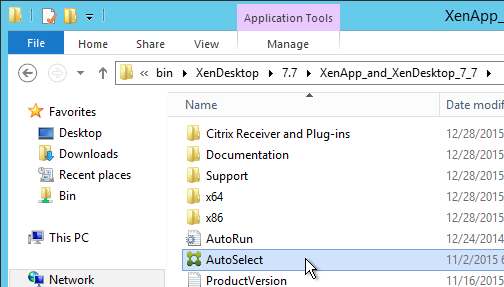
- Click Start next to either XenApp or XenDesktop. The only difference is the product name displayed in the installation wizard.
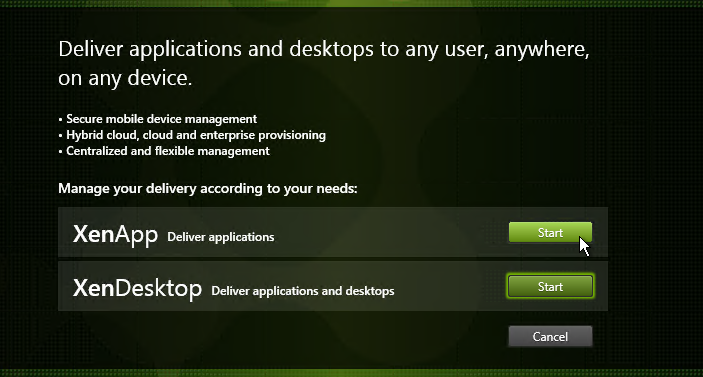
- On the left, click Delivery Controller.
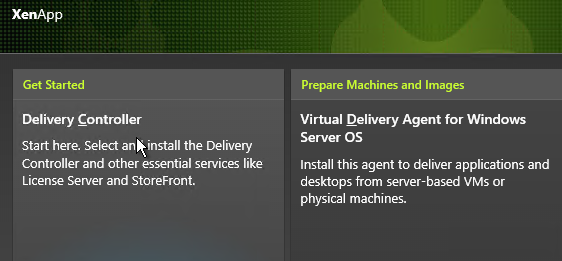
- You can install all components on one server or on separate servers. Splitting them out is only necessary in large environments or if you want to share the components (e.g. Licensing, StoreFront, Director) across multiple farms.
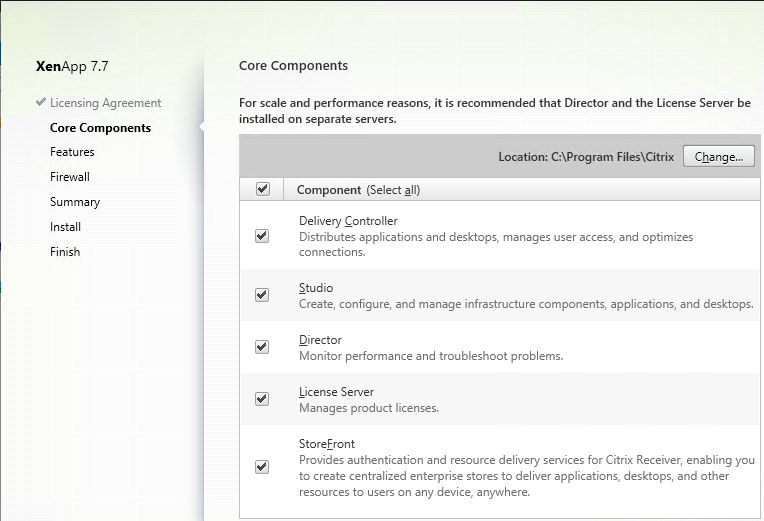
- In the Features page, uncheck the box next to Install Microsoft SQL Server 2012 SP1 Express and click Next.
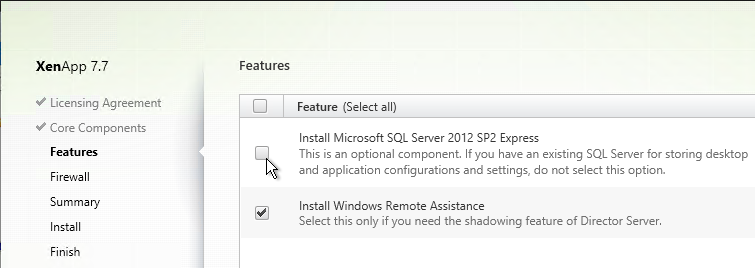
- In the Summary page, click Install.
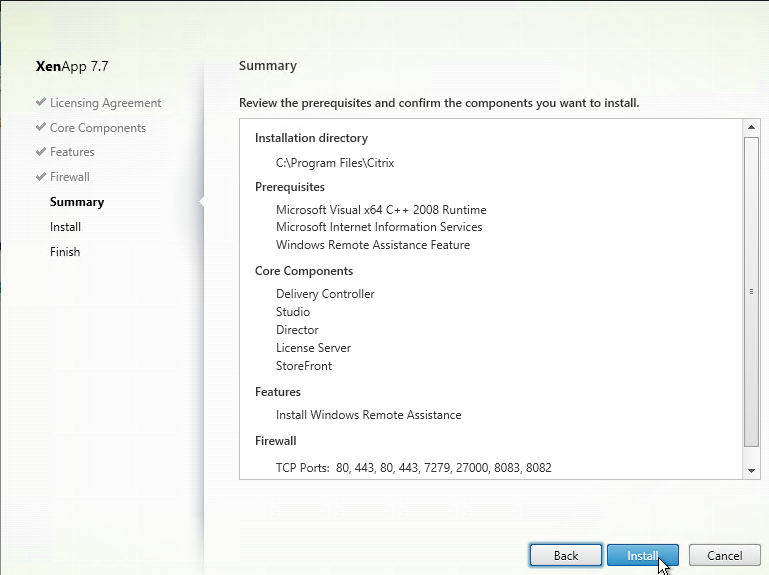
- In the Installation Successful page, click Finish. Studio will automatically launch.
- Ensure the two Controller VMs do not run on the same hypervisor host. Create an anti-affinity rule.
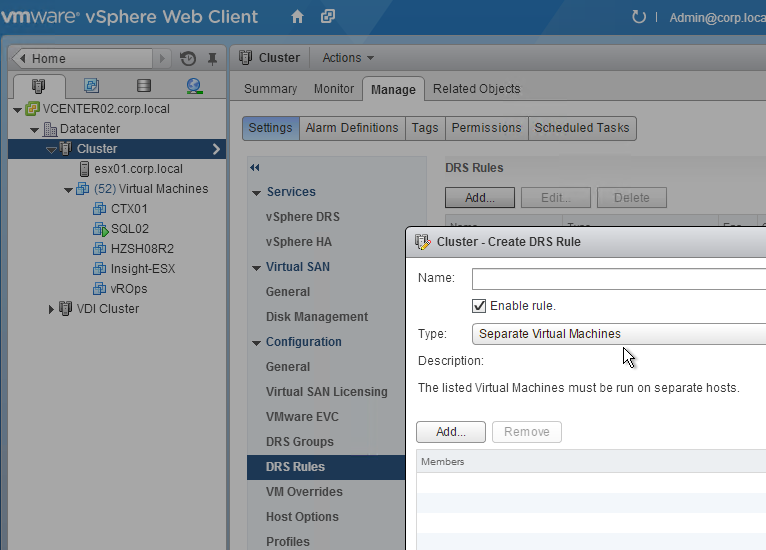
Citrix Studio 7.7 Hotfix 1
Without this fix, you can’t enter quotes in the command line arguments field of published apps.
- Go to the downloaded Citrix Studio 7.7 Hotfix 1 (DStudio770WX64001) and run DesktopStudio_x64.msi.
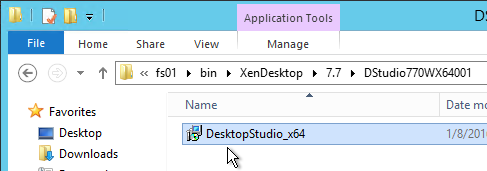
- In the Please read the Citrix Studio License Agreement page, check the box next to I accept the terms and click Install.
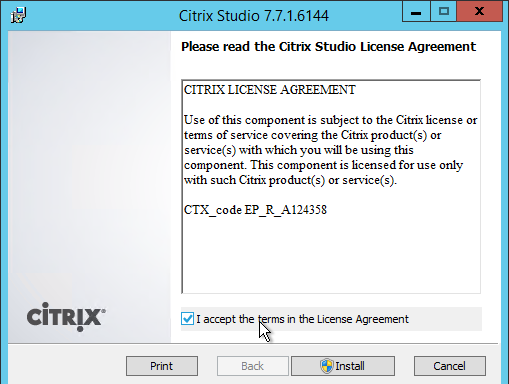
- In the Completed the Citrix Studio Setup Wizard page, click Finish.

- Programs and Features shows the updated version.
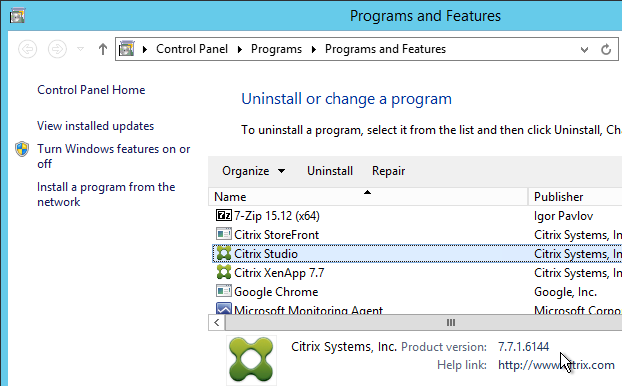
Create Site
There are several methods of creating the databases for XenApp/XenDesktop:
- If you have sysadmin permissions to SQL, let Citrix Studio create the databases automatically.
- If you don’t have sysadmin permissions to SQL then use Citrix Studio to generate SQL scripts and send them to a DBA.
Database Mirroring
If you are not using database mirroring then skip to the next section.
You can setup SQL Mirroring either before configuring XenDesktop or after configuring XenDesktop.
- If before, then the empty databases (Site, Logging, Monitoring) must use the Latin1_General_100_CI_AS_KS collation, which is not the default.
- If SQL Mirroring is already setup then XenDesktop will detect it and set the database connection strings accordingly. Or you can manually change the database connection strings later as detailed at Citrix CTX140319 How to Migrate XenDesktop Database to New SQL Server.
- If you use Citrix Studio to create SQL scripts that populate the databases, then there will be separate SQL scripts for the Primary and Partner.
To verify mirroring after the XenDesktop configuration has completed, run the PowerShell cmdlet get-configdbconnection and ensure that the Failover Partner has been set in the connection string to the mirror.

Use Studio to Create Database Scripts
- Launch Citrix Studio. After it loads, click Deliver applications and desktops to your users.
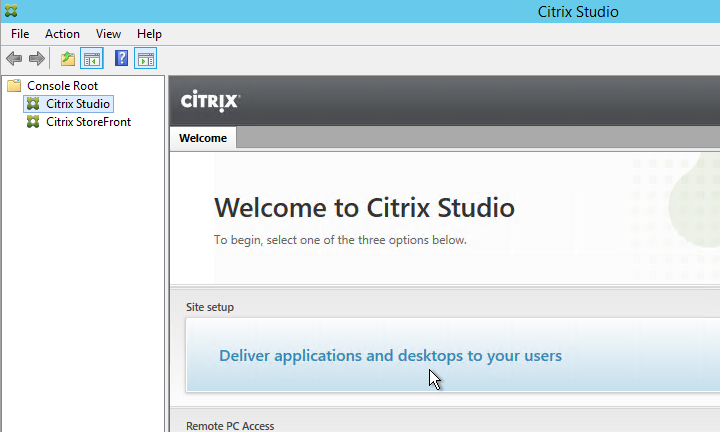
- In the Introduction page, select An empty, unconfigured site. This reduces the number of pages in this Setup wizard. The other pages will be configured later.
- Enter a Site Name (aka farm name) and click Next. Only administrators see the farm name.
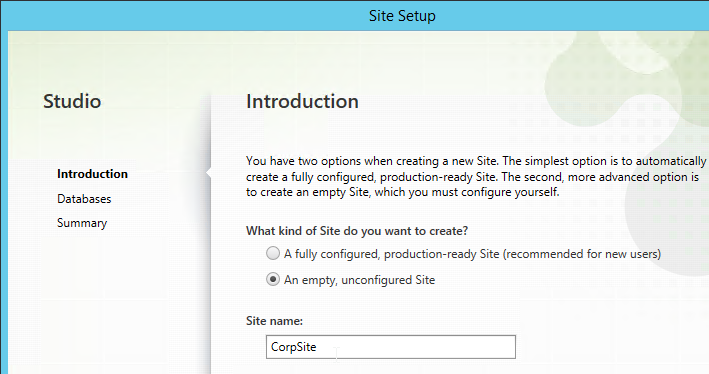
- In the Databases page, change the selection to Generate scripts to manually set up databases on the database server.
- Change the database names if desired.
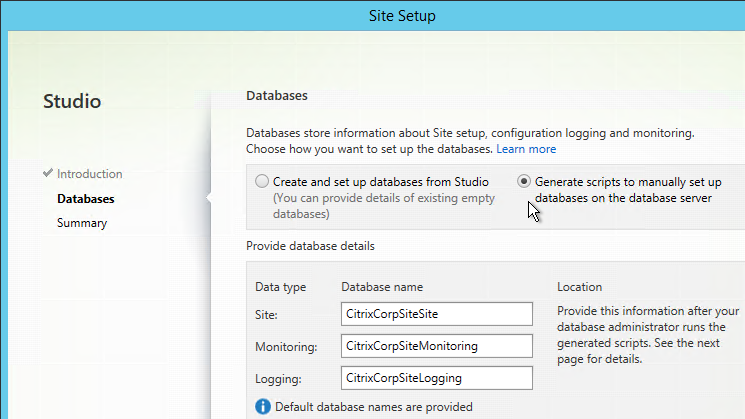
- If you are building two Controllers, click Select near the bottom of the same page.
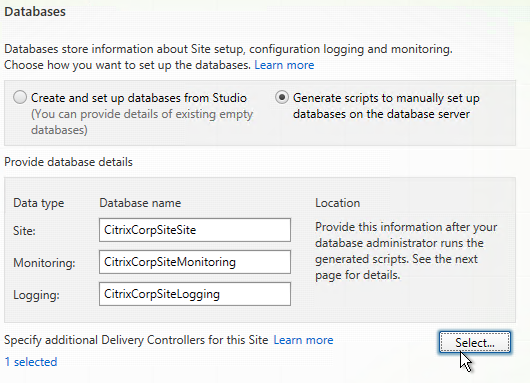
- Click Add.
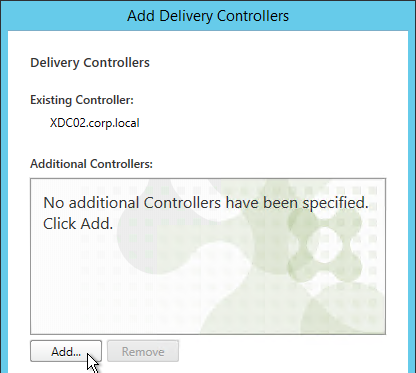
- Enter the FQDN of the second Controller and click OK. Note: the Delivery Controller software must already be installed on that machine.
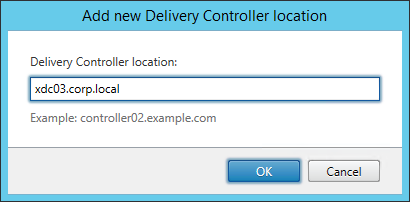
- Then click Save.
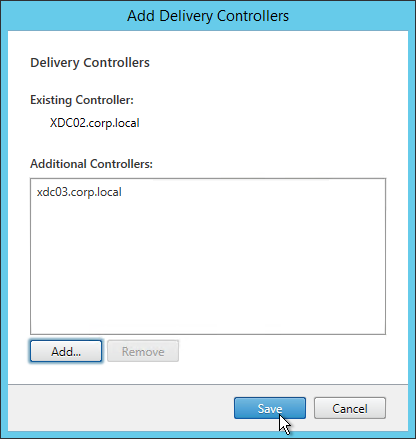
- If you hover your mouse over 2 selected, it will show both Controllers. Click Next.
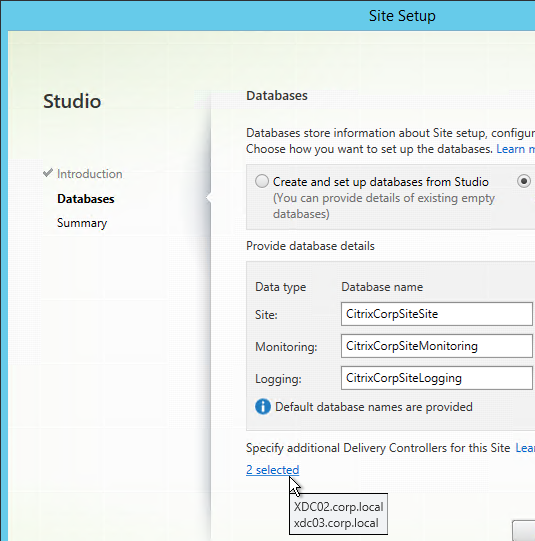
- In the Summary page, click Generate scripts.
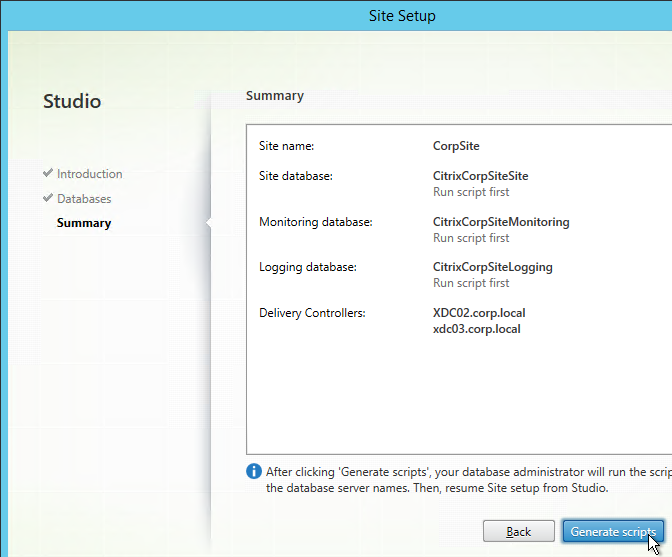
- A folder will open with six scripts. Edit each of the scripts.
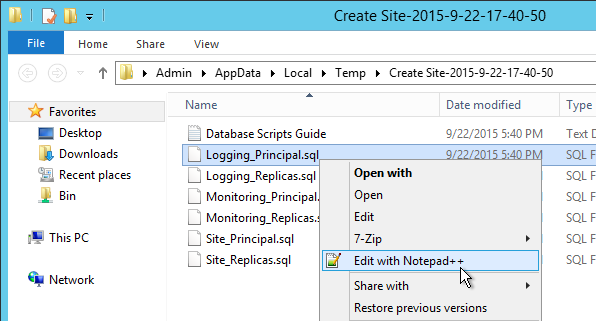
- Near the top of each script are two lines to create the database. Uncomment both lines (including the go line). Then save and close the file.

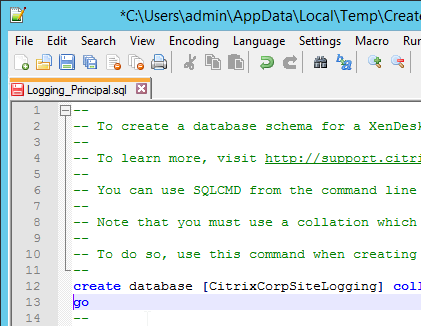
- Once all of the scripts are edited you can send them to your DBA.
- On the Principal SQL Server, open the file Site_Principal.sql.
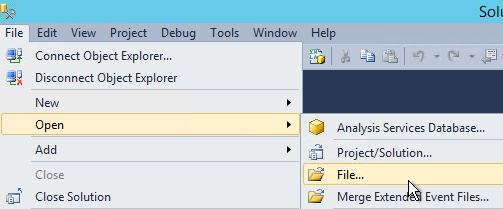
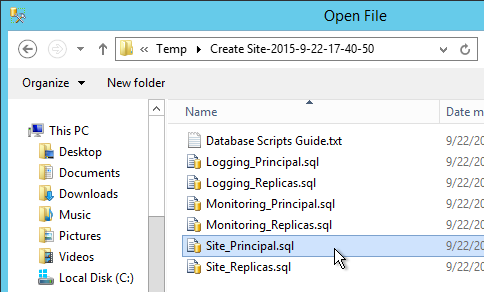
- Open the Query menu and click SQLCMD Mode.
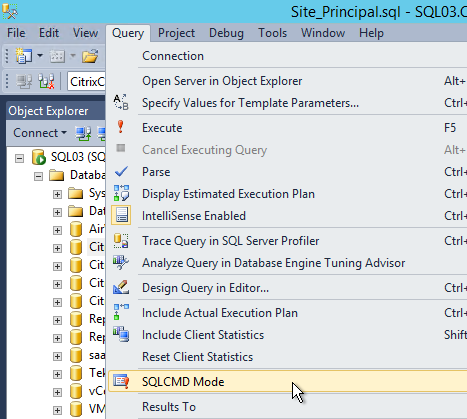
- Then execute the script.
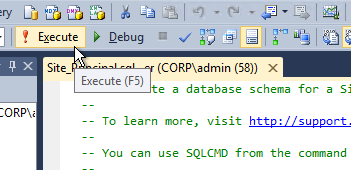
- If SQLCMD mode was enabled properly then the output should look something like this:
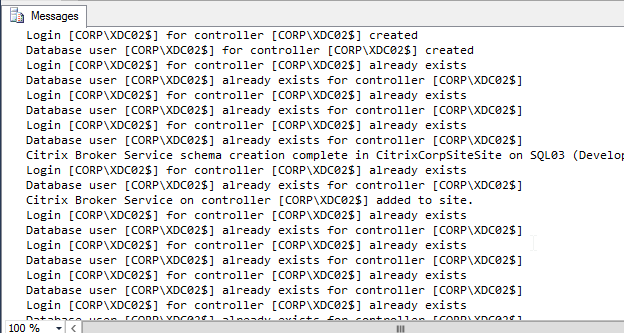
- If you have a mirrored database, run the second script on the mirror SQL instance. Make sure SQLCMD mode is enabled.
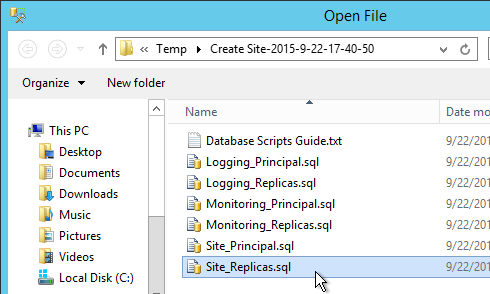

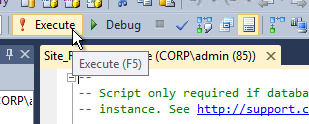
- Repeat for the Logging_Pricipal.sql script.
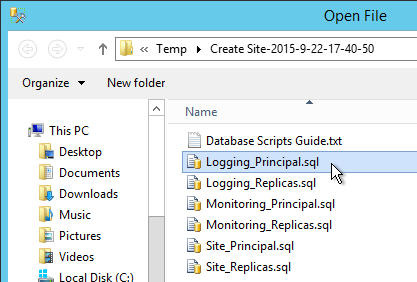
- You’ll have to enable SQLCMD Mode for each script you open.
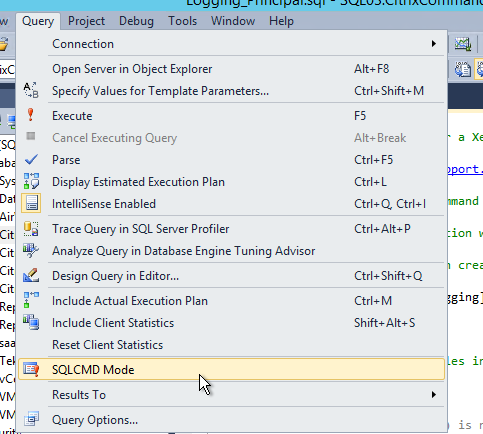
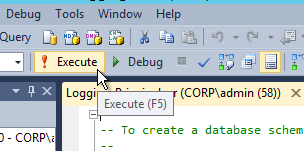

- Repeat for the Monitoring_Principal.sql script.
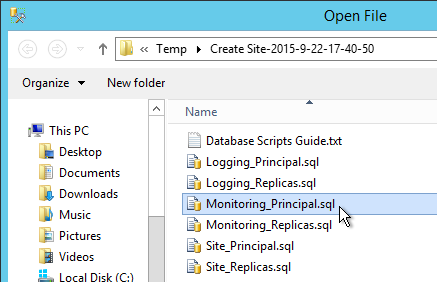
- Once again enable SQLCMD Mode.
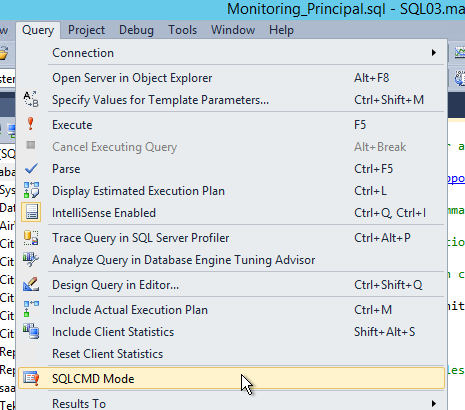
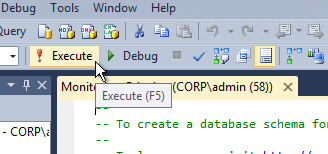
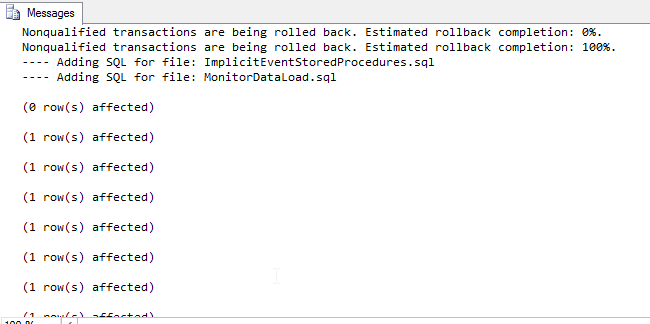
- The person running Citrix Studio must be added to the SQL Server as a SQL Login and granted the public server role.
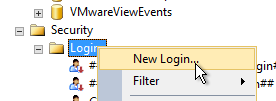
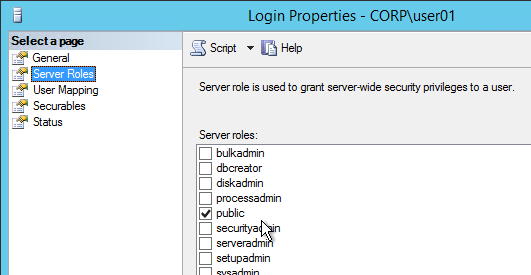
- Back in Citrix Studio, click the Continue database configuration and Site setup button.
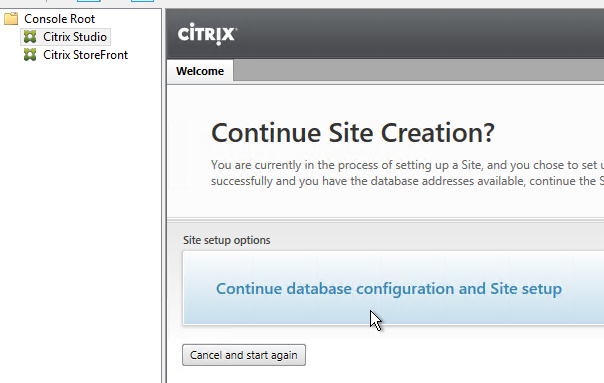
- In the Database page, enter the SQL server name and instance name and click Next.
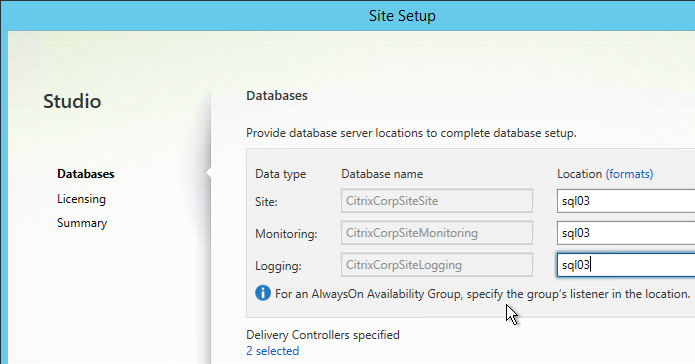
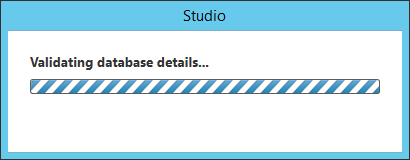
- On the Licensing page, enter the name of the Citrix License Server and click Connect.
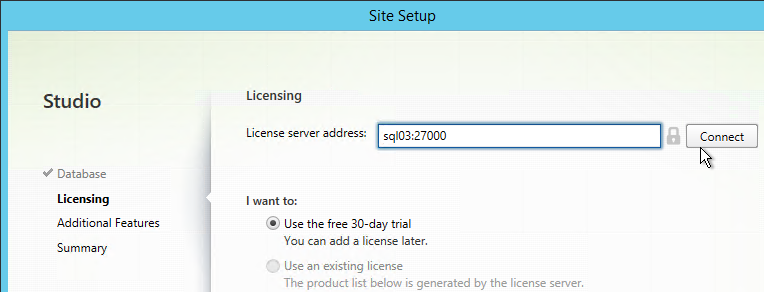
- XenApp/XenDesktop 7.7 requires the newest Licensing Server. If your server isn’t compatible, leave it set to localhost and fix it later.
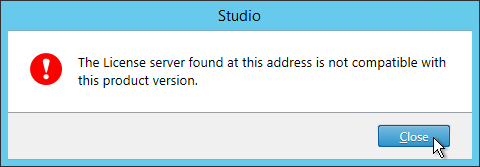
- If the Certificate Authentication appears, select Connect me and click Confirm.
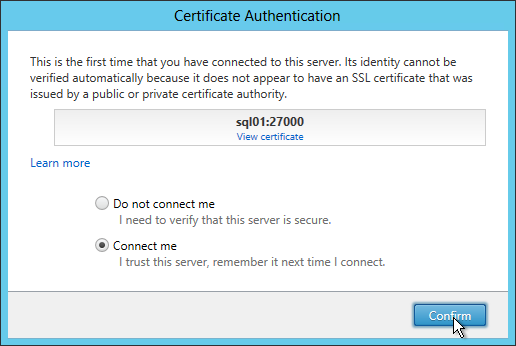
- Then select your license and click Next.

- In the Summary page, make your selection for Customer Experience Improvement Program and click Finish.
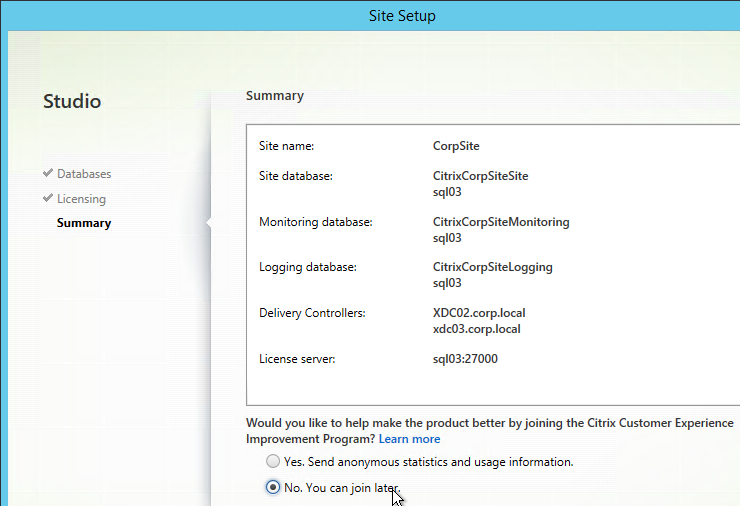
- It will take some time for the site to be created.
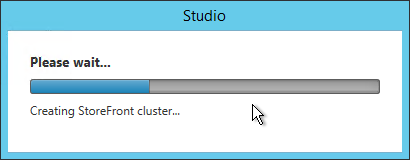
Verify Database Mirroring
If your database is mirrored, when you run get-brokerdbconnection, you’ll see the Failover Partner in the database connection string.

Second Controller
There are several methods of adding a second Controller to the databases for XenApp/XenDesktop:
- If you have sysadmin permissions to SQL, let Citrix Studio modify the databases automatically.
- If you don’t have sysadmin permissions to SQL then do use Citrix Studio to generate SQL scripts and send them to a DBA.
To use Citrix Studio to create the SQL Scripts:
- On the 1st Delivery Controller, if StoreFront is installed, delete the default StoreFront store (/Citrix/Store) and recreate it with your desired Store name (e.g. /Citrix/CompanyStore).
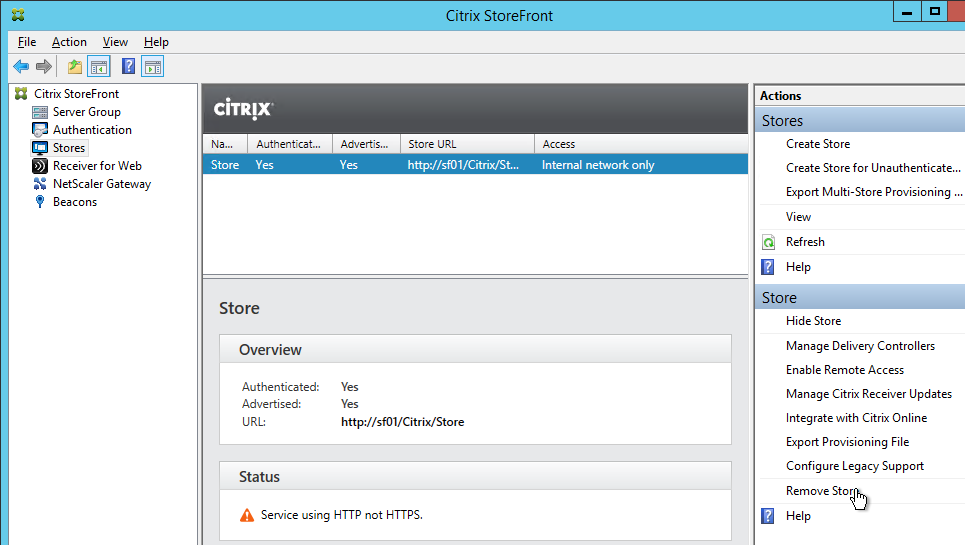
- On the 2nd Delivery Controller, install XenDesktop as detailed earlier.
- After running Studio, click Connect this Delivery Controller to an existing Site.
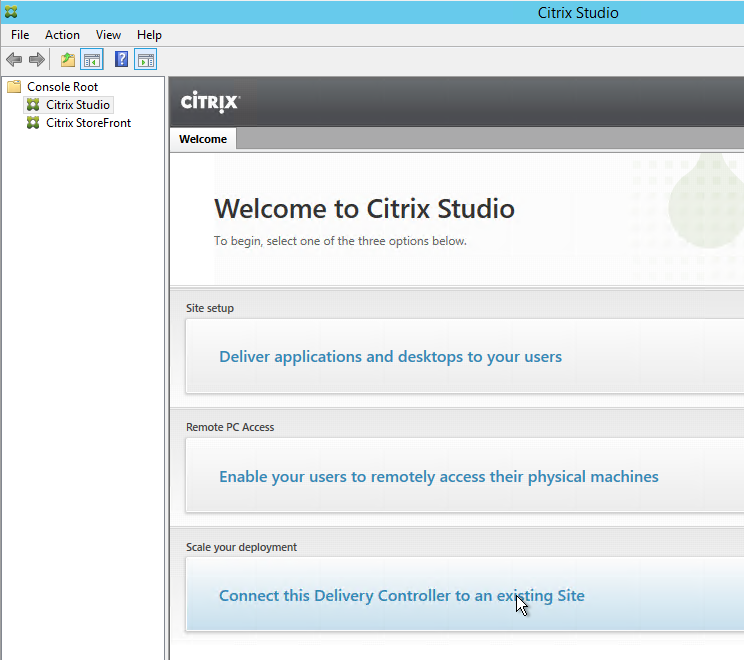
- Enter the name of the first Delivery Controller and click OK.
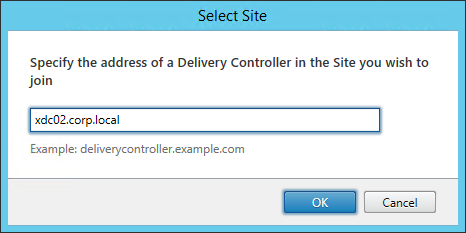
- If you don’t have elevated SQL permissions, click No when asked if you want to update the database automatically.
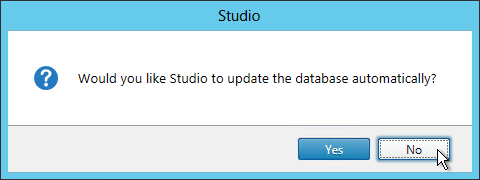
- Click Generate scripts.
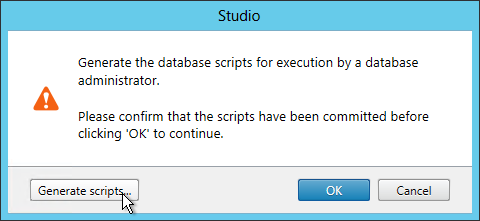
- A folder will open with six scripts. If not mirroring, then the top three scripts need to be sent to a DBA. If mirroring, send all six.
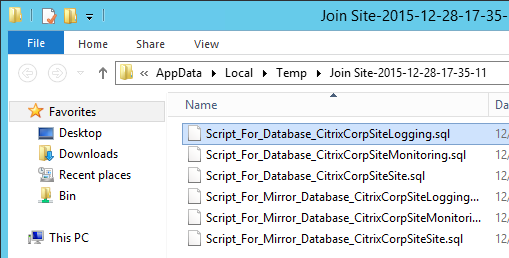
- On the SQL Server, open open one of the .sql files.
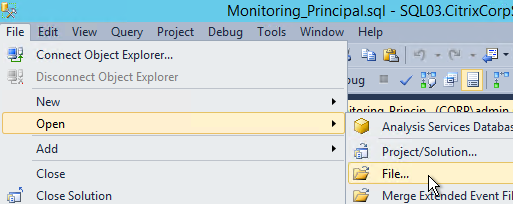
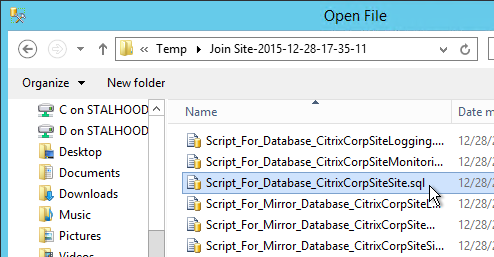
- Open the Query menu and click SQLCMD Mode.
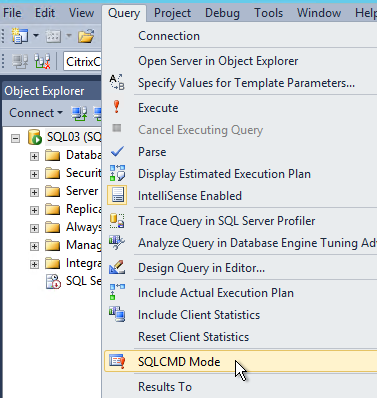
- Then execute the XenDesktop script.
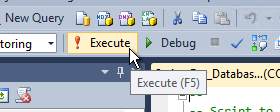
- If SQLCMD mode was enabled properly then the output should look something like this:
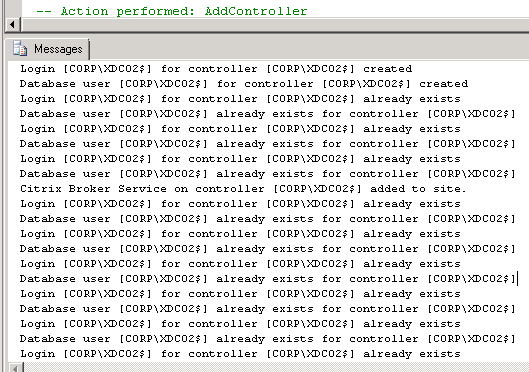
- Back in Citrix Studio, click OK.
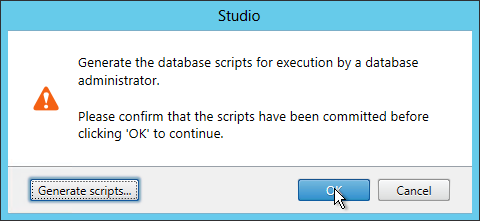
- In the Studio, under Configuration > Controllers, you should see both controllers.
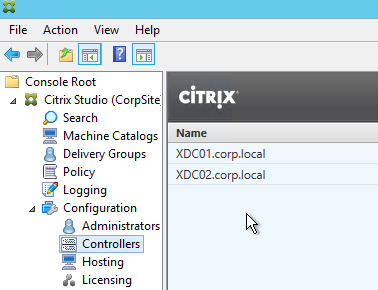
- You can also test the site again if desired.
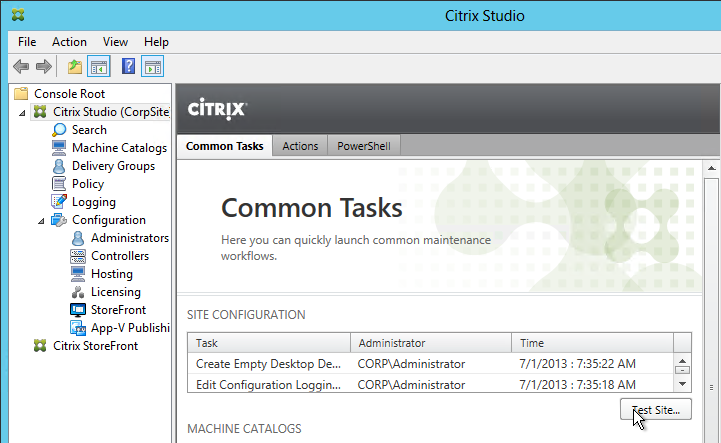
Studio – Slow Launch
From B.J.M. Groenhout at Citrix Discussions: The following adjustments can be made if Desktop Studio (and other Citrix management Consoles) will start slowly:
- Within Internet Explorer, go to Tools – Internet Options – Tab Advanced – Section Security and uncheck the option Check for publisher’s certificate revocation
After adjustment Desktop Studio (MMC) will be started immediately. Without adjustment it may take some time before Desktop Studio (MMC) is started.
Registry setting (can be deployed using Group Policy Preferences):
- HKEY_CURRENT_USER\Software\Microsoft\Windows\CurrentVersion\WinTrust\Trust Providers\Software Publishing
- “State“=dword:00023e00
Database Maintenance
View Logging Database
To view the contents of the Logging Database, in Studio, click the Logging node. On the right is Create Custom Report. See Citrix article CTX138132 Viewing Configuration Logging Data Not Shown for more info.
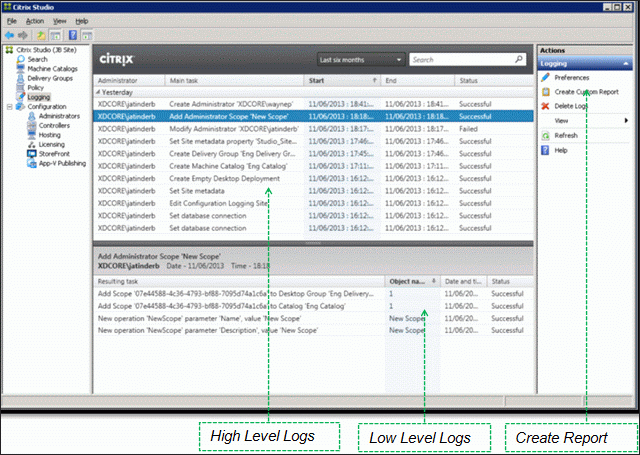
Enable Read-Committed Snapshot
The XenDesktop Database can become heavily utilized under load in a large environment. Therefore Citrix recommends enabling the Read_Committed_Snapshot option on the XenDesktop databases to remove contention on the database from read queries. This can improve the interactivity of Studio and Director. It should be noted that this option may increase the load on the tempdb files. See Citrix article CTX137161 How to Enable Read-Committed Snapshot in XenDesktop for configuration instructions.
Change Database Connection Strings
Sometimes the database connection strings need to be modified:
- When moving the SQL databases to a different SQL server
- When enabling mirroring after the databases have already been configured in Studio.
CTX140319 How to Migrate XenDesktop Database to New SQL Server has the correctly ordered list of PowerShell commands to change the database connection strings. Make sure PowerShell is running as administrator before running these commands.
Step 5 assumes Site, Monitoring, and Logging are one database so you’ll need to adjust the commands if those databases are split. In particular, change $cs in Set-LogDBConnection -DataStore Logging -DBConnection $cs to the Logging database. And change $cs in Set-MonitorDBConnection -DataStore Monitor -DBConnection $cs to the Monitoring database. The other commands don’t need to be changed.
Director Grooming
If XenDesktop is not Platinum Edition then all historical Director data is groomed at 7 days.
For XenDesktop/XenApp Platinum Edition, by default, most of the historical Director data is groomed at 90 days. This can be adjusted up to 367 days by running a PowerShell applet.
- On a Delivery Controller, run PowerShell and run asnp Citrix.*

- Run Get-MonitorConfiguration to see the current grooming settings.
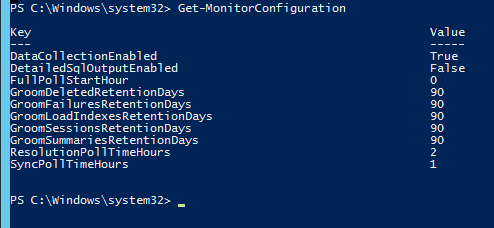
- Run Set-MonitorConfiguration to change the grooming settings.

Studio Administrators
Full Administrators
- In the Studio, under Configuration, click the Administrators node. The first time you access the node you’ll see a Welcome page. Feel free to check the box and then click Close.
- On the Administrators tab, right-click and click Create Administrator.
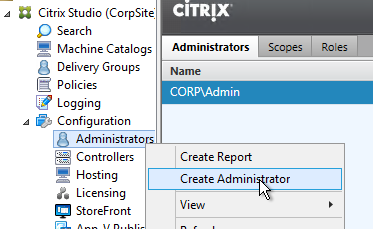
- In the Administrator and Scope page, specify a group (e.g. Citrix Admins or Help Desk) that will have permissions to Studio and Director. Click Next.
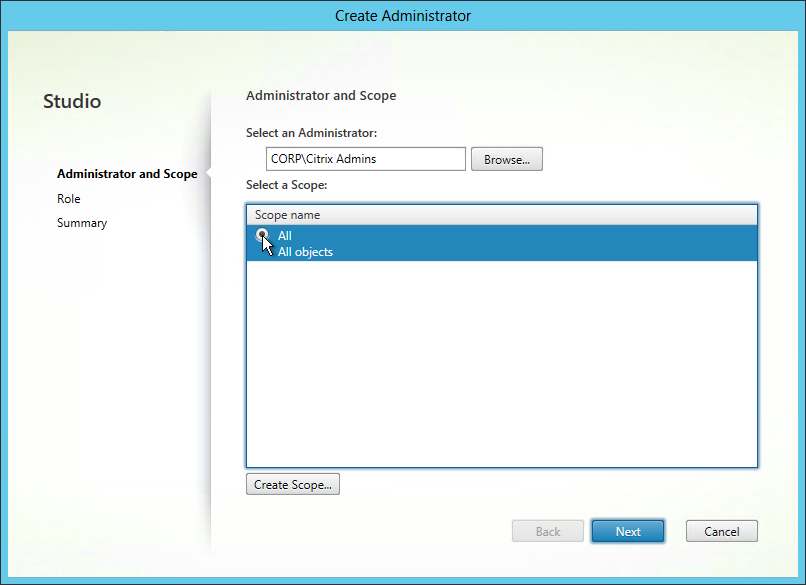
- On the Role page, select a role and then click Next. For example:
- Full Administrator for the Citrix Admins group
- Help Desk Administrator for the Help Desk group
- Machine Catalog Administrator for the desktop team
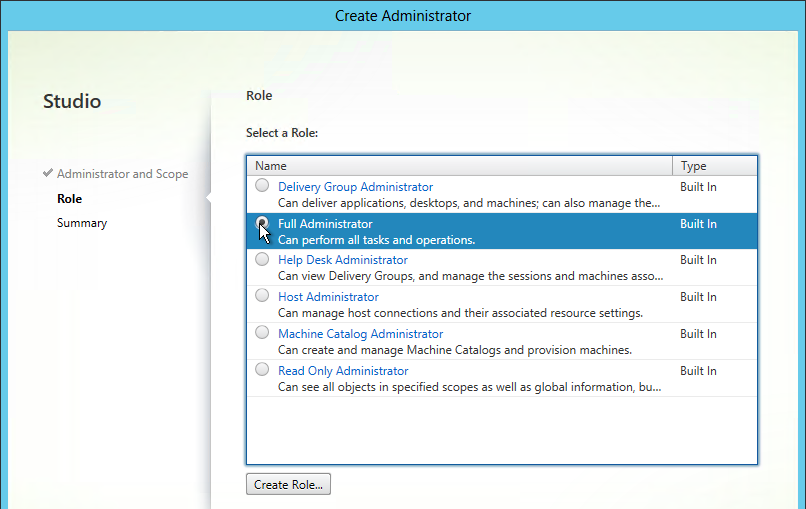
- In the Summary page, click Finish.
Help Desk
- In the Studio, under Configuration, click the Administrators node. On the Administrators tab, right-click and click Create Administrator.

- In the Administrator and Scope page, specify a Help Desk group that will have permissions to Studio and Director. Click Next.
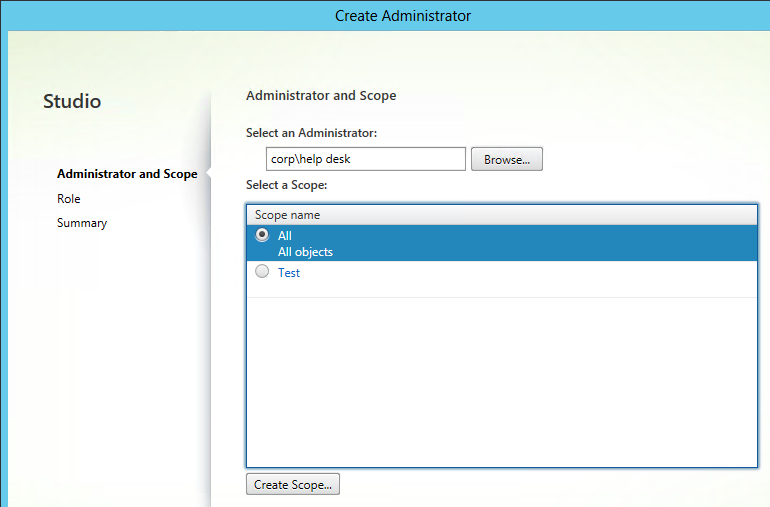
- On the Role page, select the Help Desk Administrator role and then click Next.
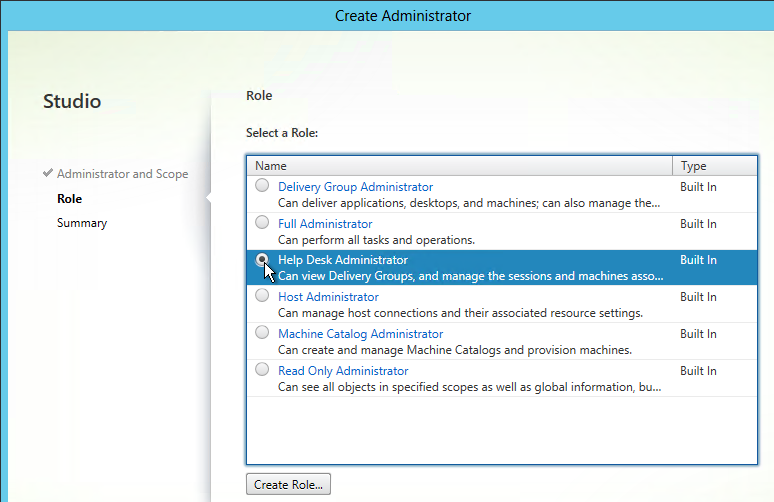
- In the Summary page, click Finish.
- When administrators in the Help Desk role log into Director, all they see is this.

To jazz it up a little, add the Help Desk group to the read-only role. - Right-click the Help Desk Administrator and click Edit Administrator.
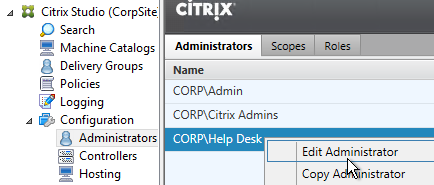
- Click Add.
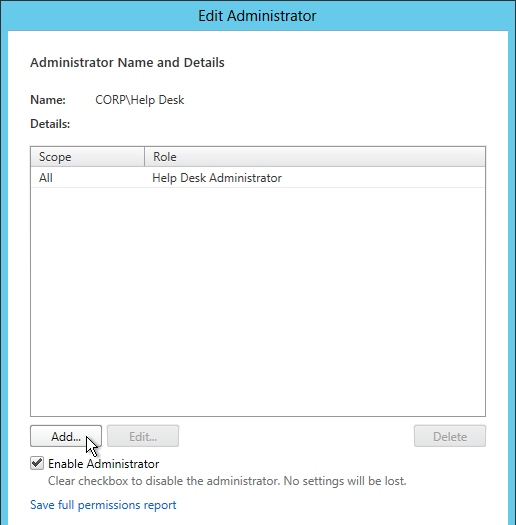
- In the Scope page, select a scope and click Next.
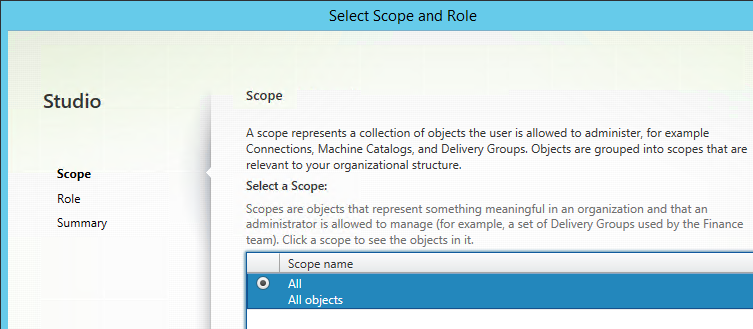
- In the Role page, select Read Only Administrator and click Next.
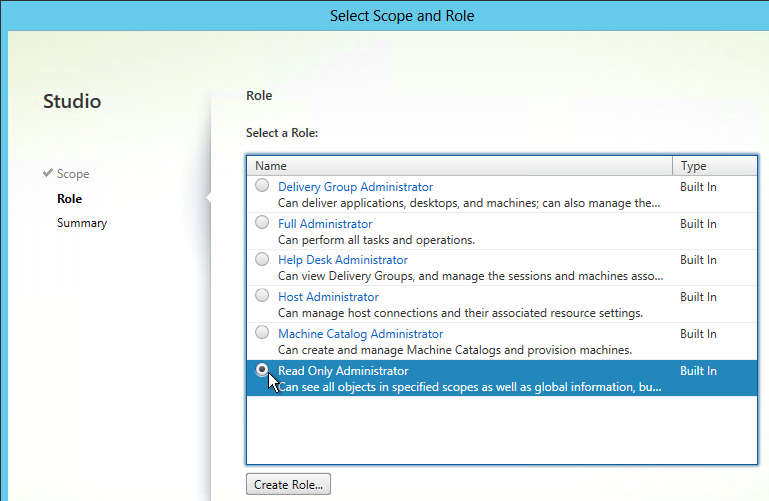
- In the Summary page, click Finish.
- Then click OK. Now Director will display the dashboard.
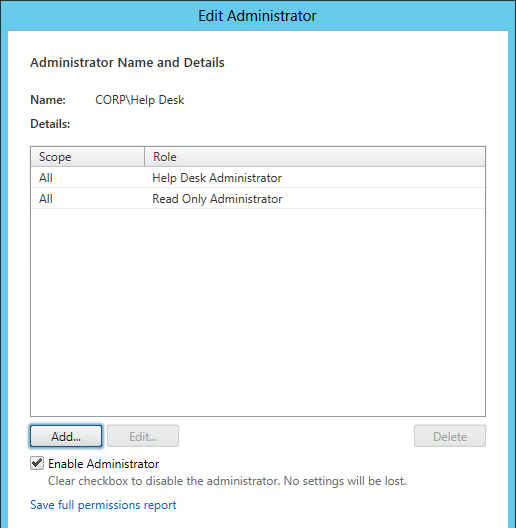
Provisioning Services w/Personal vDisk
From Citrix docs.citrix.com: The Provisioning Services Soap Service account must be added to the Administrator node of Studio and must have the Machine Administrator or higher role. This ensures that the PvD desktops are put into the Preparing state when the Provisioning Services (PVS) vDisk is promoted to production.
vCenter Connection
XenDesktop uses an Active Directory service account to log into vCenter. This account needs specific permissions in vCenter. To facilitate assigning these permissions, create a new vCenter role and assign it to the XenDesktop service account. The permissions should be applied at the datacenter or higher level. CTX214389 How to Define VMware vSphere User Privileges for XenApp and XenDesktop defines the minimum permissions needed for various activities in XenDesktop: MCS, PvS, Power Management, and AppDisks. 💡
Import vCenter Certificate
If you replaced the certificates on your vCenter server, then skip this section.
If vCenter is using a self-signed certificate, in order for Delivery Controller to trust the vCenter certificate, you must import the vCenter certificate on both Delivery Controllers.
- Open a browser and connect to your vCenter Server.
- Click the padlock and then view the certificate.
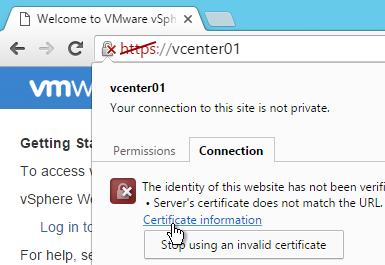
- On the Details tab, click Copy to File.
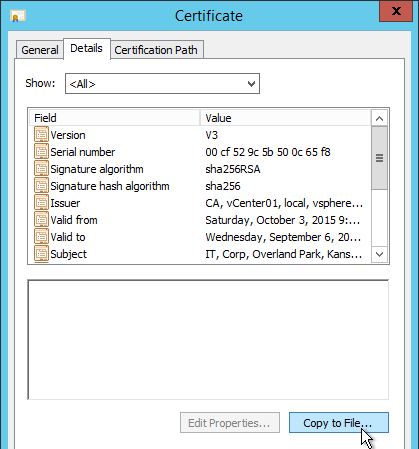
- Save the certificate in any format.
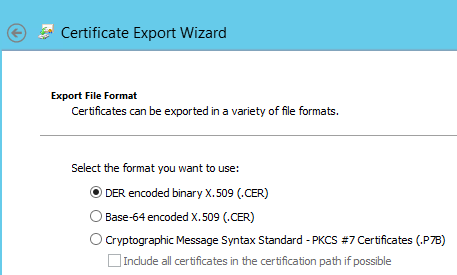
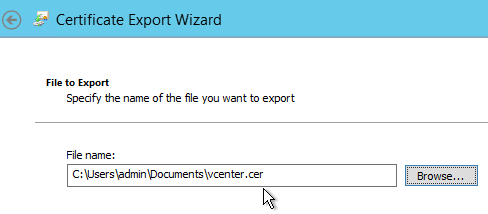
- On each Delivery Controller, run mmc.exe. Open the File menu and click Add/Remove Snap-in. If your server is Windows Server 2012 R2 or newer, you can skip a few steps by running certlm.msc.
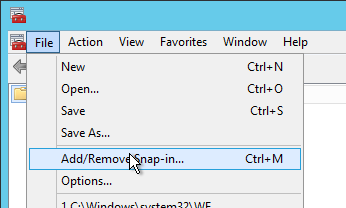
- Move the Certificates snap-in to the right by highlighting it and clicking Add.
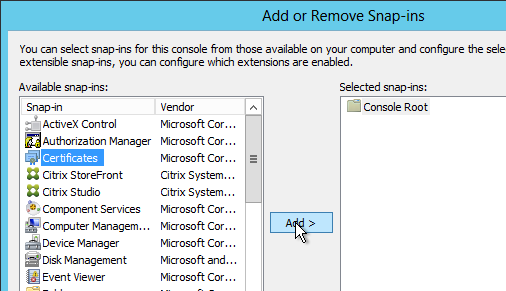
- Select Computer account and click Next.

- Select Local computer and click Finish.
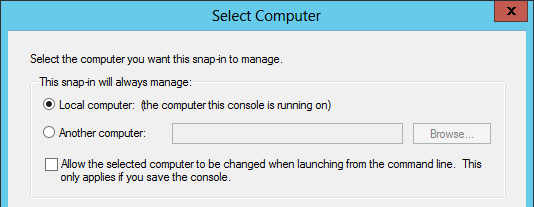
- Click OK.
- After adding the snap-in, right-click the Trusted People node, expand All Tasks and click Import.
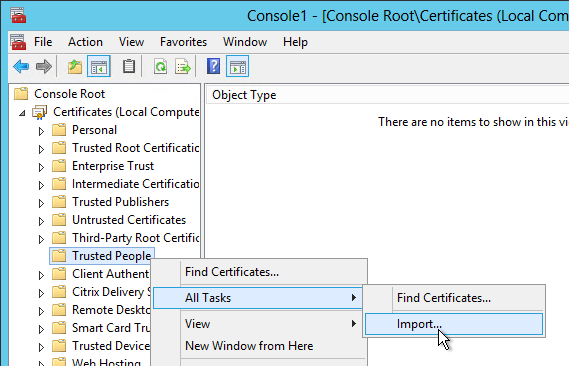
- In the Welcome to the Certificate Import Wizard page, click Next.
- In the File to Import page, browse to the certificate file you exported earlier. Click Next.
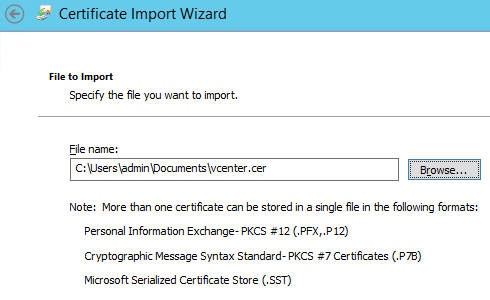
- In the Certificate Store page, click Next.
- In the Completing the Certificate Import Wizard page, click Finish.
- Click OK to acknowledge that the import was successful.
- Repeat these steps on the second Controller. It is important that you do both Controllers before adding the vCenter connection.
Hosting Resources
A Hosting Resource = vCenter + Cluster (Resource Pool) + Storage + Network. When you create a machine catalog, you select a previously defined Hosting Resource and the Cluster, Storage, and Network defined in the Hosting Resource object are automatically selected. If you need some desktops on a different Cluster+Storage+Network then you’ll need to define more Hosting Resources in Studio.
- In Studio, expand Configuration and click Hosting. Right-click it and click Add Connection and Resources.
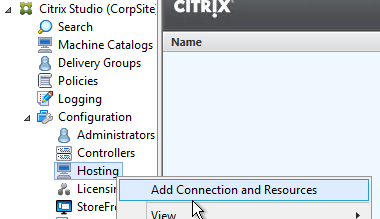
- In the Connection page, select VMware vSphere as the Host type.
- Enter https://vcenter01.corp.local/sdk as the vCenter URL. The URL must contain the FQDN of the vCenter server. If the vCenter certificate is self-signed, ensure it is added to the Trusted People certificate store on all Delivery Controllers. Ensure the entered URL has /sdk on the end.
- Enter credentials of a service account. Click Next.
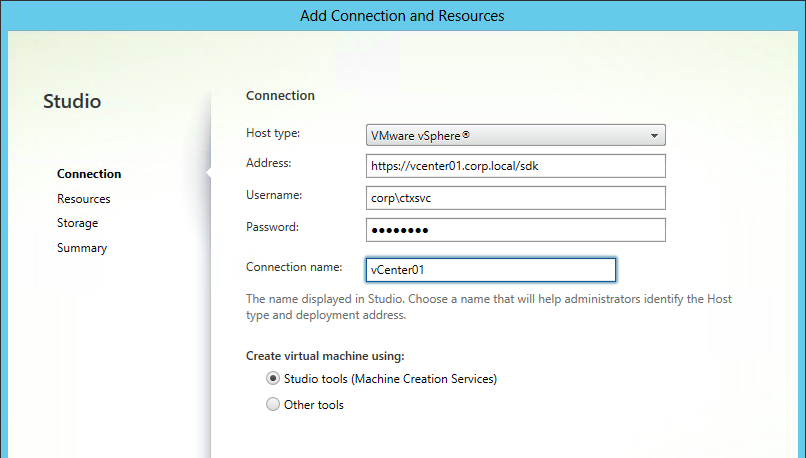
- Enter a name for the hosting resource. Since each hosting resource is a combination of vCenter, Cluster, Network, and Datastore, include those names in this field (e.g. vCenter01-Cluster01-Network01-Datastore01).
- In the Cluster page, click Browse and select a cluster or resource pool.
- Select a network and click Next.
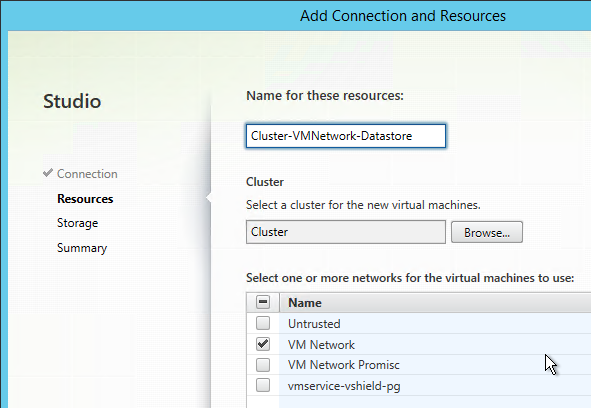
- On the Storage page, select a datastore for the virtual machines. Maximum flexibility is achievable if you only select one datastore per hosting resource. Create additional hosting resources for each datastore.
- If desired, change the selection for personal vDisk to use a different storage. Click Next.
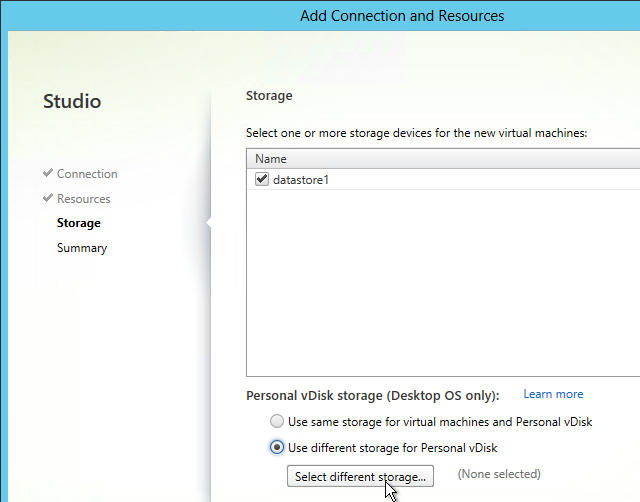
- In the Summary page, click Finish.
Citrix Director
Director on Standalone Server
If you are installing Director 7.7 on a standalone server, see Citrix CTX142260 Installing or Upgrading to Citrix Director 7.6.200
- If you intend to install Director on a standalone server, start with running AutoSelect.exe from the XenApp/XenDesktop 7.7 media.
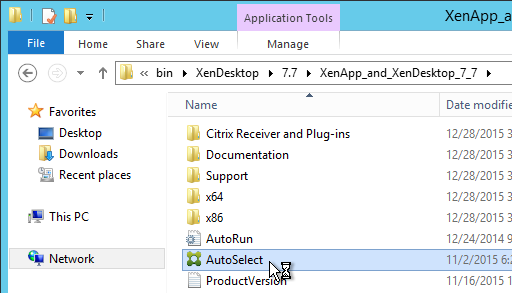
- On the right, click Citrix Director.
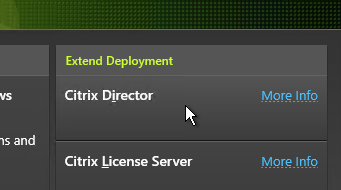
- It will ask you for the location of one Controller in the farm. Then finish the installation wizard.

- In IIS Manager, go to Default Web Site > Director > Application Settings, find Service.AutoDiscoveryAddresses and make sure it points to a Controller and not to localhost.
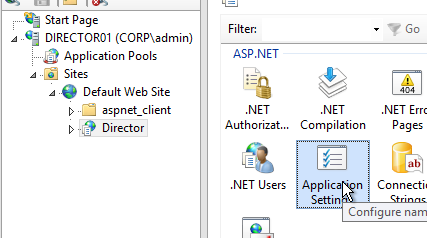
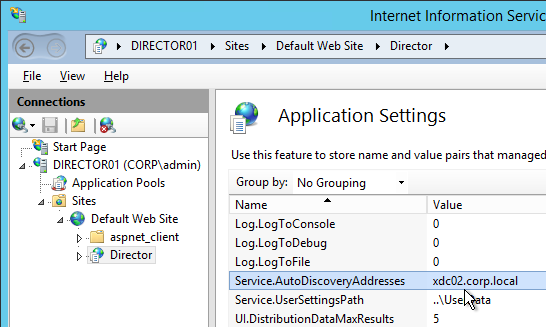
- If you built multiple Director servers, then use NetScaler to load balance them.
Director Single Sign-on
You can configure Director 7.7 to support Integrated Windows Authentication (Single Sign-on). Note: there seem to be issues when not connecting from the local machine or when connecting through a load balancer.
- Run IIS Manager. You can launch it from Server Manager (Tools menu) or from the Start Menu or by running inetmgr.
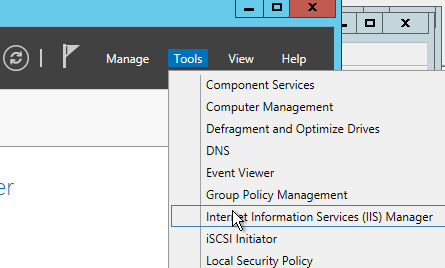
- On the left, expand Sites, expand Default Web Site, and click Director.
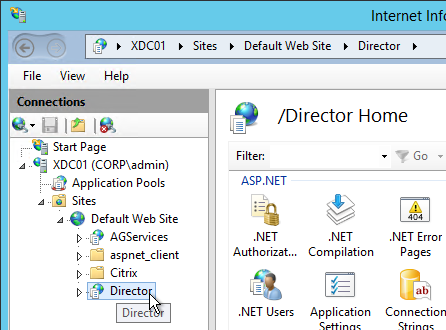
- In the middle, double-click Authentication in the IIS section.
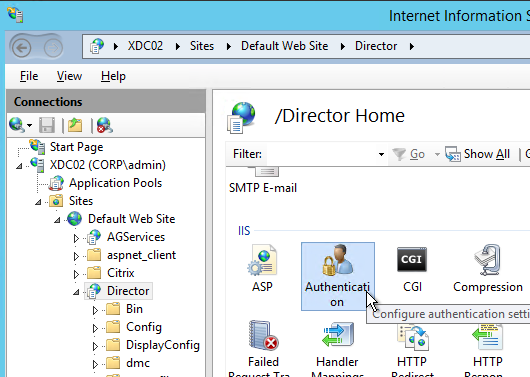
- Right-click Windows Authentication and Enable it.
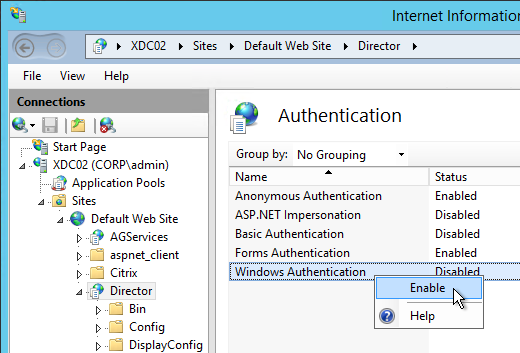
- Right-click Anonymous Authentication and Disable it.
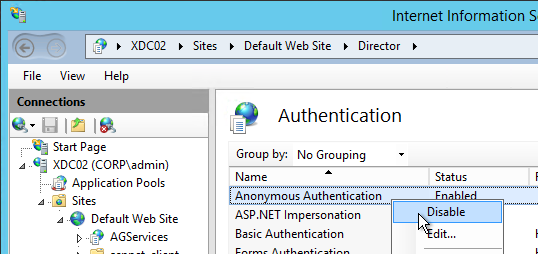
- Pass-through auth won’t work from another computer until you set the http SPN for the Director server. See Director 7.7 Windows Authentication not working with NS LB at discussions.citrix.com.

- If Director is not installed on a Controller then you’ll need to configure Kerberos delegation.
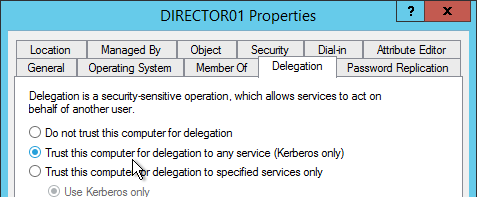
- If you are load balancing Director then additional config is required. See Director 7.7 Windows Authentication not working with NS LB at discussions.citrix.com for more info.
- Create an AD service account that will be used as the Director’s ApplicationPoolIdentity.
- Create SPN and link it to the service account.
setspn -S http/loadbalanced_URL domain\user
- Trust the user account for delegation to any service (Kerberos only) (trust the Director servers for delegation is not necessary in this case). You have to create the SPN before you can do this step.
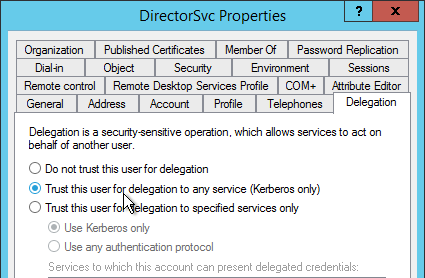
- In IIS manager, on the Application Pools (Director), specify the Identity as user we have created in step 1.
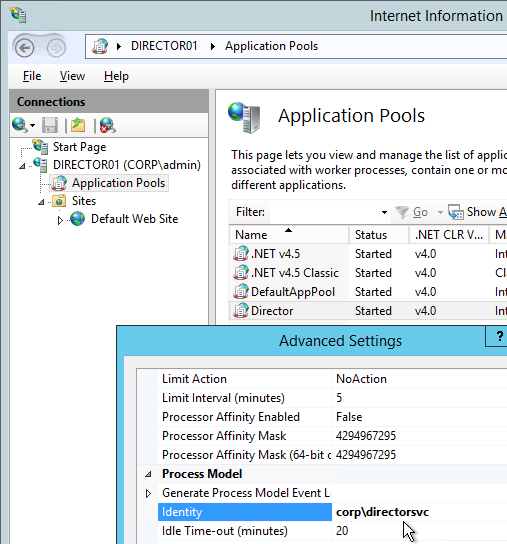
- In IIS manager, select Default Web Site and open the Configuration Editor.
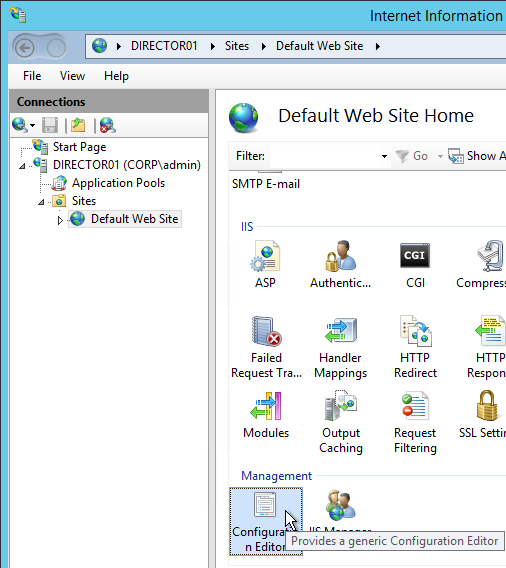
- Use the drop-down to navigate to the following section:
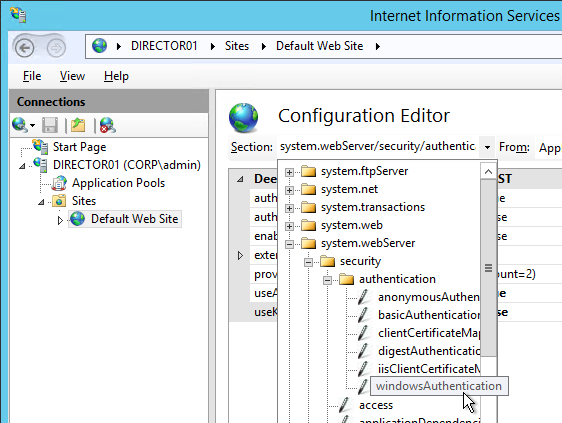
system.webServer/security/authentication/windowsAuthentication
- Set useAppPoolCredentials = True and useKernelMode = False. Click Apply on the top right.
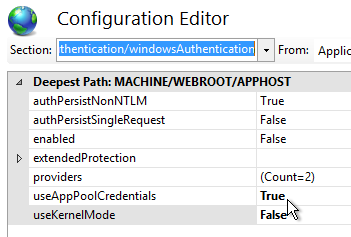
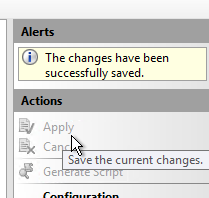
- When you connect to Director you will be automatically logged in. You can change the login account by first logging off.
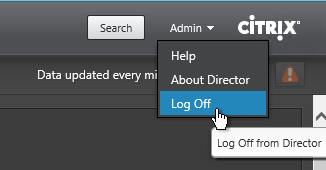
- Then change the drop-down to User credentials.
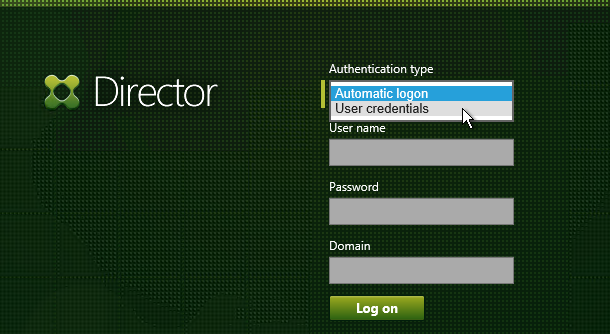
Director – Multiple XenDesktop Sites
- Run IIS Manager. You can launch it from Server Manager (Tools menu) or from the Start Menu or by running inetmgr.

- On the left, expand Sites, expand Default Web Site, and click Director.

- In the middle pane, double-click Application Settings.
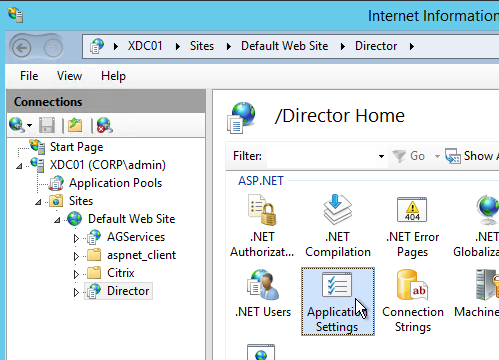
- Find the entry for Service.AutoDiscoveryAddresses and double-click it.
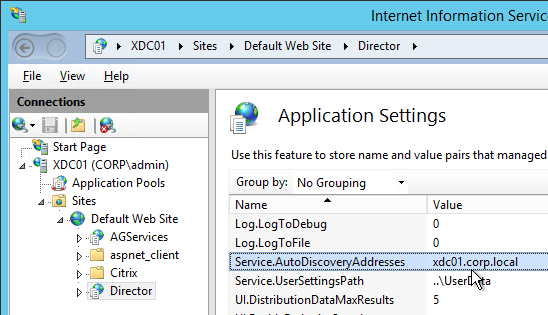
- If Director is installed on a Controller, localhost should already be entered.
- Add a comma and the NetBIOS name of one of the controllers in the 2nd XenDesktop Site (farm). Only enter one Controller name. If you have multiple Director servers, you can point each Director server to a different Controller in the 2nd XenDesktop Site (farm).
- According to Citrix CTX200543 Desktop Director Access Fails After XenDesktop 7.5 is Upgraded to 7.6, the addresses should be NetBIOS names, not FQDN. Click OK.
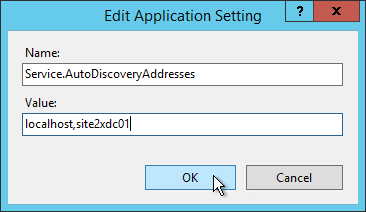
Director Alerts and Notifications
Director 7.7 supports alert conditions and email notifications. This feature requires XenApp/XenDesktop to be licensed with Platinum Edition. See Citrix Blog Post Configuring & Managing Alerts and Notifications Using Director for more information.
- While logged into Director, at the top of the page click the Alerts button.

- Switch to the Email Server Configuration tab.
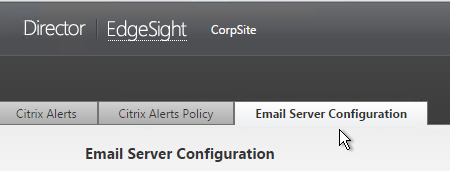
- Enter your SMTP information and click Send Test Message. Then click Save.
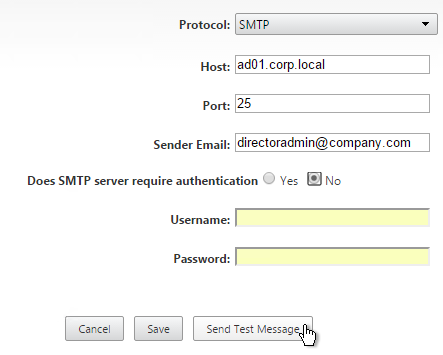
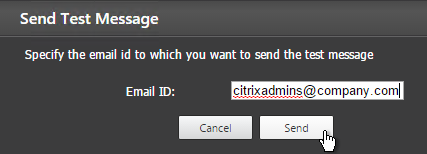
- Switch to the Citrix Alerts Policy tab.
- There are three high-level categories of alerts: Site Policy, Delivery Group Policy, and Server OS Policy. Click whichever one you want to configure.
- Then click Create.
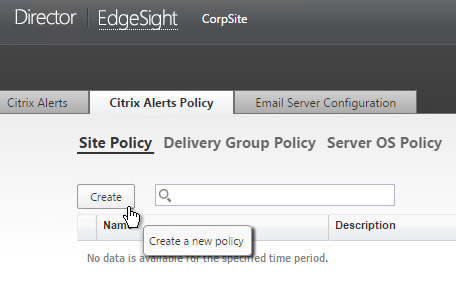
- Give the alert a name.
- On the bottom left, select a condition and enter thresholds.
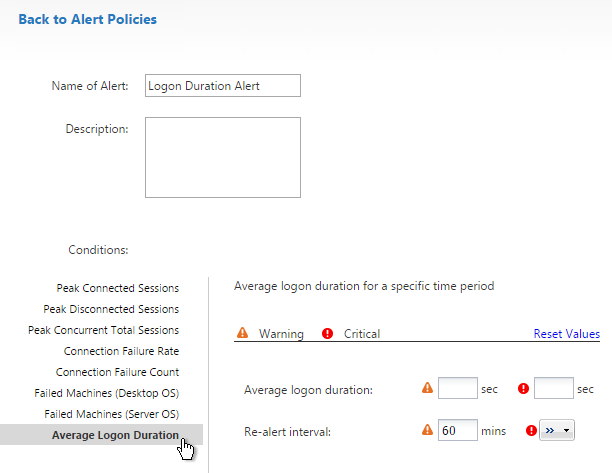
- On the bottom right, in the Notifications preferences section, click Add.
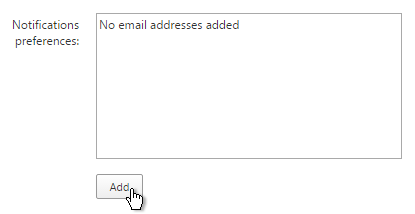
- Enter an email address and click Add.

- Click Save when done. Feel free to create more alerts and notifications.

- Citrix has an experimental Desktop Notification Tool. See Citrix Blog Post Desktop Notification Tool For Citrix XenDesktop. 💡

Director – SCOM Integration
Director 7.7 can display alerts from System Center Operations Manager 2012 R2. This feature requires XenApp/XenDesktop Platinum Edition.
- See Configure SCOM integration at docs.citrix.com for detailed configuration instructions. Also see Marius Sandbu Integrating Citrix XenDesktop 7.7 and System Center Operations Manager.
- If Director server or System Center Operations Manager server is 2008 R2, then login to the 2008 R2 server, open PowerShell and run Enable-PSRemoting. Yes to everything. This is not needed on Windows Server 2012 R2 servers.
- On Director 7.7 server, run C:\inetpub\wwwroot\Director\tools\DirectorConfig.exe /configscom
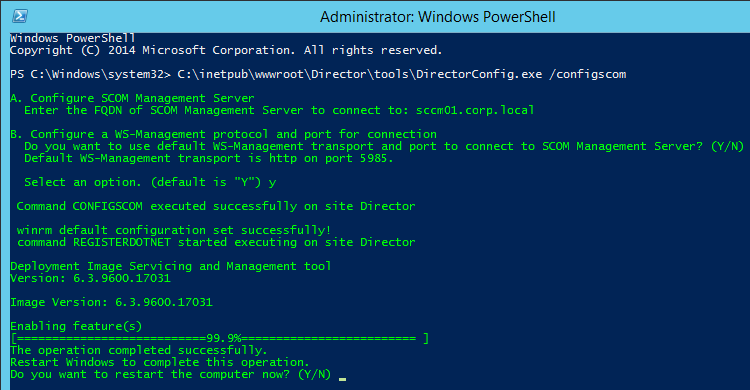
- FYI, the DirectorConfig.exe /configscom command enables the following features on the Director server: /FeatureName:IIS-NetFxExtensibility45 /FeatureName:IIS-ASPNET45 /FeatureName:WCF-HTTP-Activation45
- FYI, the System Center Operations Manager server is listed in IIS Manager at Default Web Site > Director > Application Settings (middle pane) > Connector.SCOM.ManagementServer.
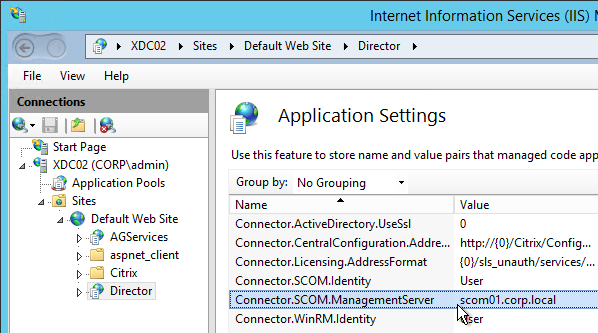
- On the System Center Operations Manager server, edit Remote Management Users local group and add Citrix Admins and other Director users.
- In System Center Operations Manager Console, go to Administration > User Roles and edit Operations Manager Operators. Add the Citrix Admins and other Director users.
- See Citrix Blog Post SCOM Alerts in Citrix Director for information on how to view System Center Operations Manager alerts in Director.
Director Tweaks
Prepopulate the domain field
From http://www.xenblog.dk/?p=33: On the Controllers having the Director role installed, locate and edit the ‘LogOn.aspx’ file. By default you can find it at “C:\inetpub\wwwroot\Director\Logon.aspx”
In line 450 you will have the following. To find the line, search for ID=”Domain”. Note: onblur and onfocus attributes were added in newer versions of Director.
<asp:TextBox ID="Domain" runat="server" CssClass="text-box" onfocus="showIndicator(this);" onblur="hideIndicator(this);"></asp:TextBox>
In the ID=”Domain” element, insert a Text attribute and set it to your domain name. Don’t change or add any other attributes. Save the file.
<asp:TextBox ID="Domain" runat="server" Text="Corp" CssClass="text-box" onfocus="showIndicator(this);" onblur="hideIndicator(this);"></asp:TextBox>
This will prepopulate the domain field text box with your domain name and still allow the user to change it, if that should be required. Note: this only seems to work if Single Sign-on is disabled.
Session timeout
By default the idle time session limit of the Director is 245 min. If you wish to change the timeout, here is how to do it.
- Log on to the Director Server as an administrator
- Open the ‘IIS Manager’
- Browse to ‘SitesDefault Web SiteDirector’ in the left hand pane.
- Open ‘Session State’ in the right hand pane
- Change the ‘Time-out (in minutes)’ value under ‘Cookie Settings’
- Click ‘Apply’ in the Actions list
SSL Check
From http://euc.consulting/blog/citrix-desktop-director-2-1: If you are not securing Director with an SSL certificate you will get this error at the logon screen.

To stop this:
- Log on to the Director Server as an administrator
- Open the ‘IIS Manager’
- Browse to ‘SitesDefault Web SiteDirector’ in the left hand pane.
- Open ‘Application Settings’ in the right hand pane
- Set EnableSslCheck to false.
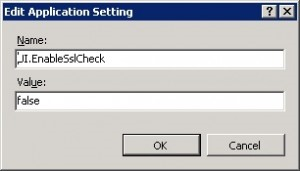
Disable Activity Manager
From docs.citrix.com: By default, the Activity Manager in Director displays a list of all the running applications and the Windows description in the title bars of any open applications for the user’s session. This information can be viewed by all administrators that have access to the Activity Manager feature in Director. For Delegated Administrator roles, this includes Full administrator, Delivery Group administrator, and Help Desk Administrator.
To protect the privacy of users and the applications they are running, you can disable the Applications tab from listing running applications.
- On the VDA, modify the registry key located at HKLM\Software\Citrix\Director\TaskManagerDataDisplayed. By default, the key is set to 1. Change the value to 0, which means the information will not be displayed in the Activity Manager.
- On the server with Director installed, modify the setting that controls the visibility of running applications. By default, the value is true, which allows visibility of running applications in the Applications Change the value to false, which disables visibility. This option affects only the Activity Manager in Director, not the VDA. Modify the value of the following setting:
UI.TaskManager.EnableApplications = false
Large Active Directory
From CTX133013 Desktop Director User Account Search Process is Slow or Fails: By default, all the Global Catalogs for the Active Directory Forest are searched using Lightweight Directory Access Protocol (LDAP). In a large Active Directory environment, this query can take some time or even time out.
- In Information Server (IIS) Management, under the Desktop Director site, select Application Settings and add a new value called ActiveDirectory.ForestSearch. Set it to False. This disables searching any domain except the user’s domain and the server’s domain.
- To search more domains, add the searchable domain or domains in the ActiveDirectory.Domains field.
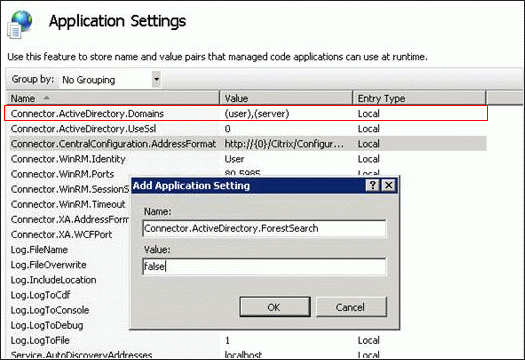
Site Groups
From Citrix Blog Post Citrix Director 7.6 Deep-Dive Part 4: Troubleshooting Machines:
If there are a large number of machines, the Director administrator can now configure site groups to perform machine search so that they can narrow down searching for the machine inside a site group. The site groups can be created on the Director server by running the configuration tool via command line by running the command:
C:\inetpub\wwwroot\Director\tools\DirectorConfig.exe /createsitegroups
Then provide a site group name and IP address of the delivery controller of the site to create the site group.
Director – Saved Filters
From Scott Osborne and Jarian Gibson at Citrix Discussions: In Director, you can create a filter and save it.
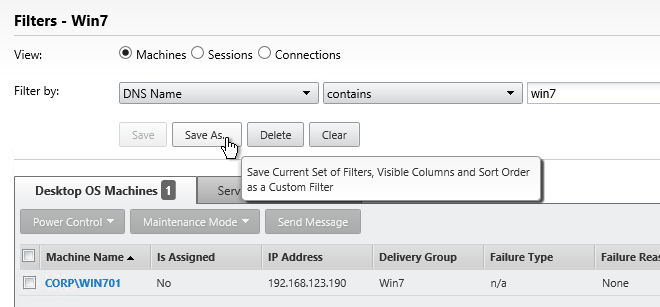

The saved filter is then accessible from the Filters menu structure.

The saved filters are stored on each Director server at C:\Inetpub\wwwroot\Director\UserData. Observations:
- Each user has their own saved filters.
- The saved filters are not replicated across Director servers. You can schedule a robocopy script to do this automatically.
- When upgrading Director, the saved filters are deleted?

Director – Custom and Scheduled Reports
The Monitoring database contains more data than is exposed in Director. To view this data, the Monitoring service has an OData Data Feed that can be queried.
You can use Excel to pull data from the OData Data feed. See Citrix Blog Post – Citrix Director – Analyzing the Monitoring Data by Means of Custom Reports. This particular blog post shows how to use an Excel PivotChart to display the connected Receiver versions.
Or for Linqpad, see Citrix Blog Post – Creating Director Custom reports for Monitoring XenDesktop using Linqpad
Go to Citrix Blog Post Obtain XenDesktop Custom report through Citrix Director and download the tool. Once installed you can create custom reports from within Director.
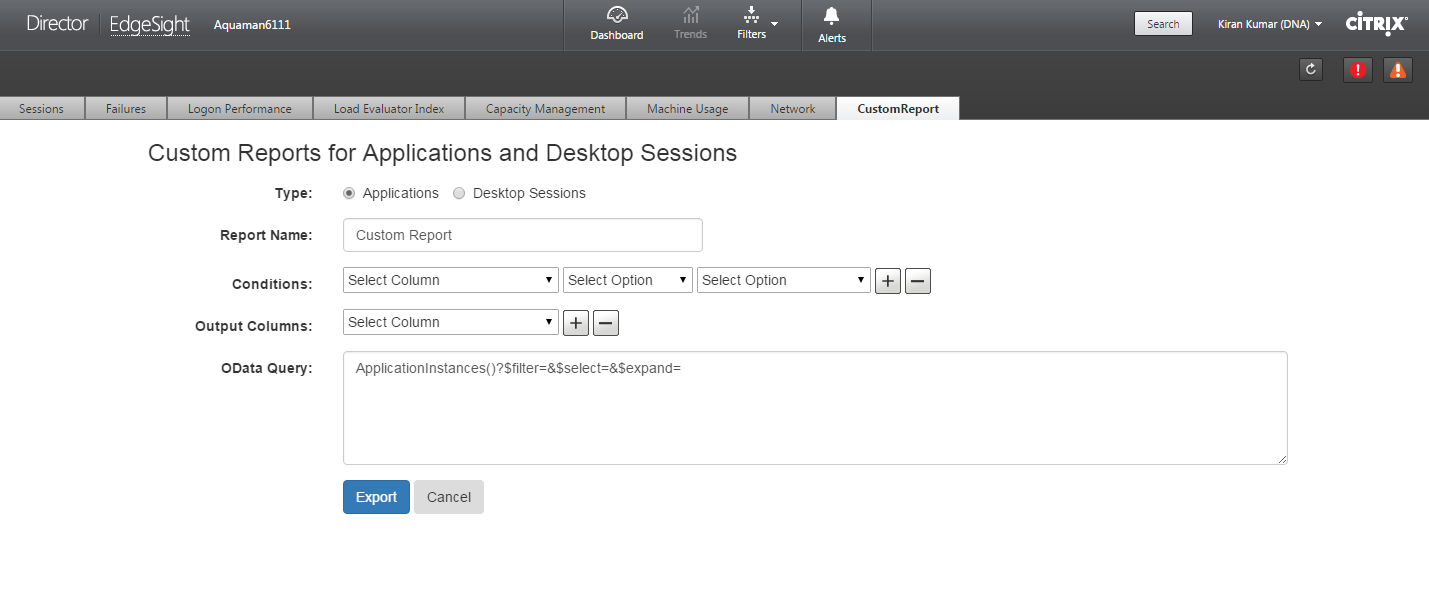
Citrix Licensing Server
Upgrade
Upgrade Citrix Licensing to 11.13.1.2. This is newer than what’s on the XenApp/XenDesktop 7.7 ISO. 💡
- Go to the downloaded Citrix Licensing 11.13.1.2 build 16002 and run CitrixLicensing.exe.

- Click Upgrade.
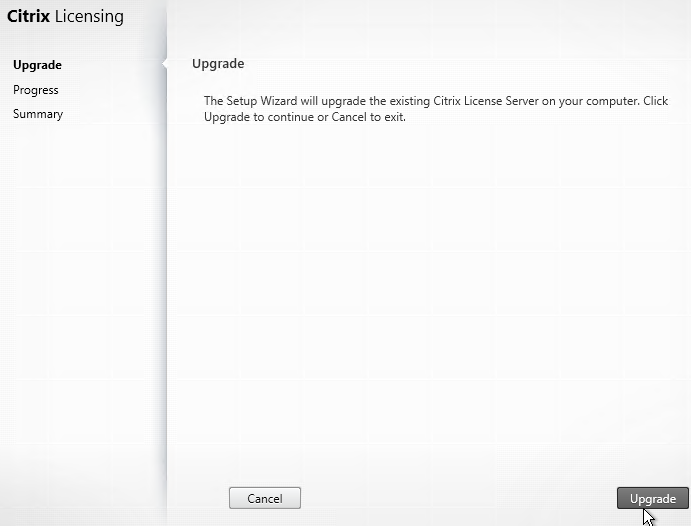
- Click Finish.
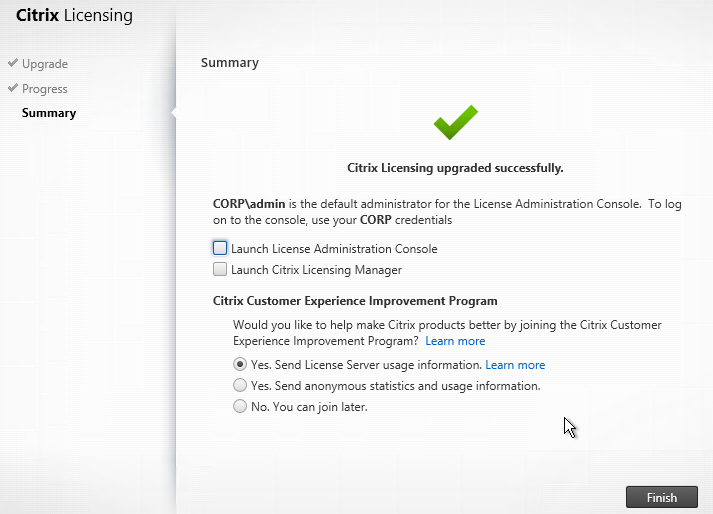
- If you go to Programs and Features, it should now show version 11.1.0.16002.
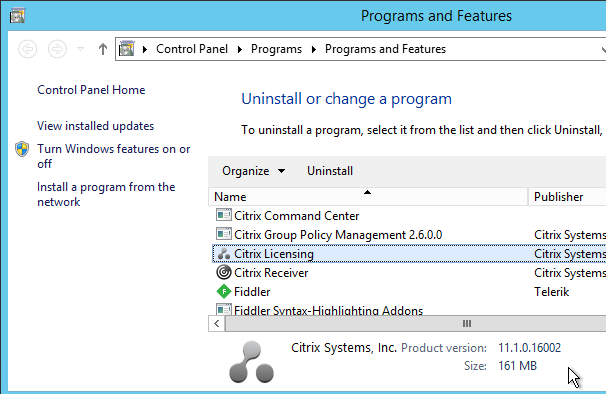
- If you login to the license server web console, on the Administration tab, it shows it as version 11.13.1 build 16002.
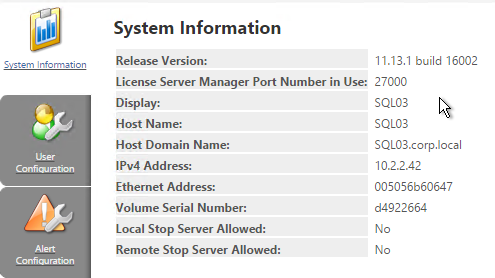
- You can also view the version in the registry at HKLM\Software\Wow6432Node\Citrix\LicenseServer\Install.
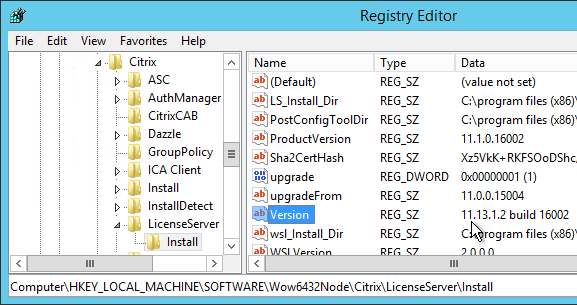
Licensing Server HA using GSLB
From Dane Young – Creating a Bulletproof Citrix Licensing Server Infrastructure using NetScaler Global Server Load Balancing (GSLB) and CtxLicChk.ps1 PowerShell Scripts. Here is a summary of the configuration steps. See the blog post for detailed configuration instructions.
- Build two License Servers in each datacenter with identical server names. Since server names are identical, they can’t be domain-joined.
- Install identical licenses on all License Servers.
- Set the DisableStrictNameChecking registry key on all Citrix Licensing servers.
- Synchronize the certificate files located at C:\Program Files (x86)\Citrix\Licensing\WebServicesForLicensing\Apache\conf. They must be identical on all Licensing Servers.
- Download CtxLicChk.exe from http://support.citrix.com/article/CTX123935 and place on all Licensing Servers.
- Schedule the PowerShell script CtxLicChk.ps1 on all Licensing Servers. Get this script from the blog post linked above.
- Configure NetScaler:
- Configure GSLB ADNS services.
- Add wildcard Load Balancing service for each Citrix Licensing Server.
- Configure service TCP monitoring for ports 27000, 7279, 8082, and 8083.
- Create Load Balancing Virtual Server for each Licensing Server.
- Set one Load Balancing Virtual Server as backup for the other.
- Repeat in second datacenter.
- Configure GSLB Services and GSLB Monitoring.
- Configure GSLB Virtual Servers. Set one GSLB Virtual Server as backup for the other.
- Delegate the Citrix Licensing DNS name to the ADNS services on the NetScaler appliances.
- Configure Citrix Studio to point to the GSLB-enabled DNS name for Citrix Licensing.
Citrix License Server Monitoring
Citrix Licensing 11.13.1 and newer has historical usage reporting: 💡
- Run Citrix Licensing Manager from the Start Menu. Or use a browser to connect to https://MyLicenseServer:8083
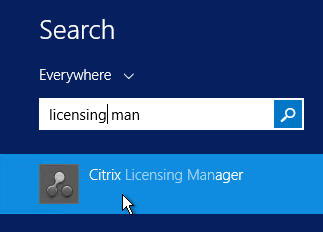
- Use the drop-down menus to select a license type, select dates, and export to a .csv file.
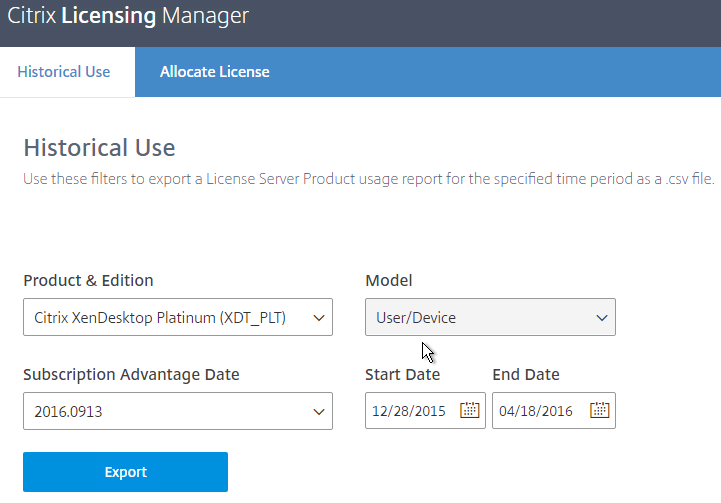
- On the top right is a gear icon where you can set the historical retention period.
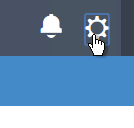
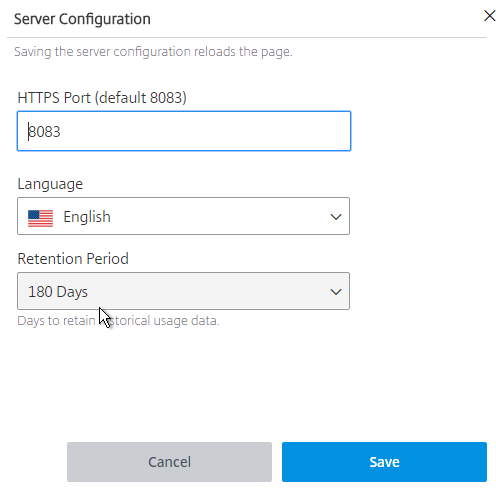
http://www.jonathanmedd.net/2011/01/monitor-citrix-license-usage-with-powershell.html.
Lal Mohan – Citrix License Usage Monitoring Using Powershell
Jaroslaw Sobel – Monitoring Citrix Licenses usage – Graphs using WMI, Powershell and RRDtool. This script generates a graph similar to the following:
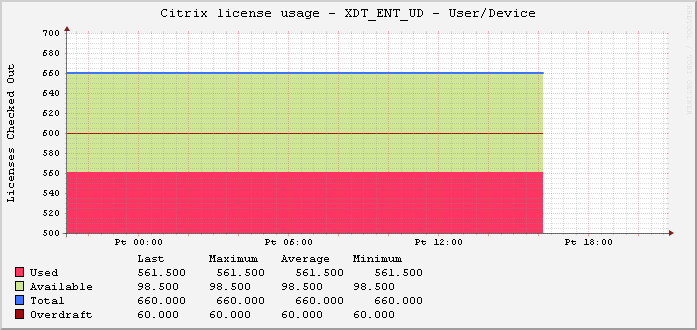

Remote Desktop Licensing Server
Install Remote Desktop Licensing Server
Do the following on your XenDesktop Controllers:
- In Server Manager, open the Manage menu and click Add Roles and Features.
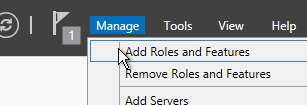
- Click Next until you get to the Server Roles page. Check the box next to Remote Desktop Services and click Next.
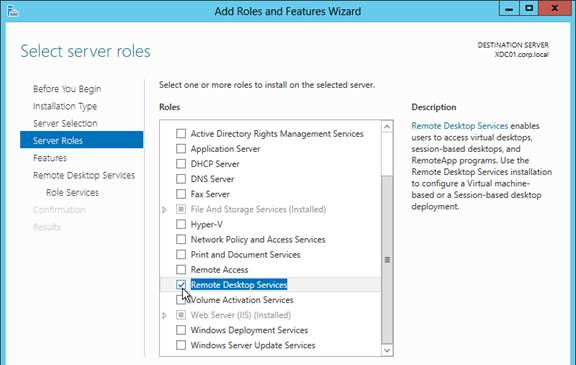
- Click Next until you get to the Role Services page. Check the box next to Remote Desktop Licensing and click Next.
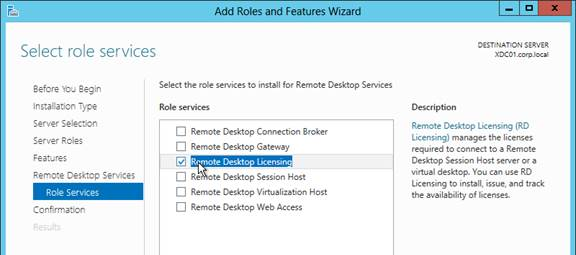
- Click Add Features if prompted.
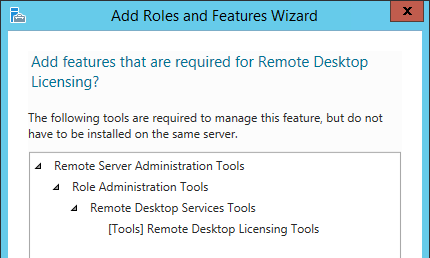
- Then finish the wizard to install the role service.
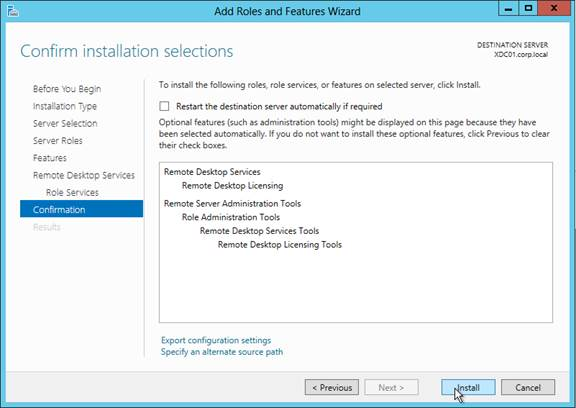
Activate Remote Desktop Licensing
- After RD Licensing is installed, in Server Manager, open the Tool menu, expand Terminal Services and click Remote Desktop Licensing Manager.
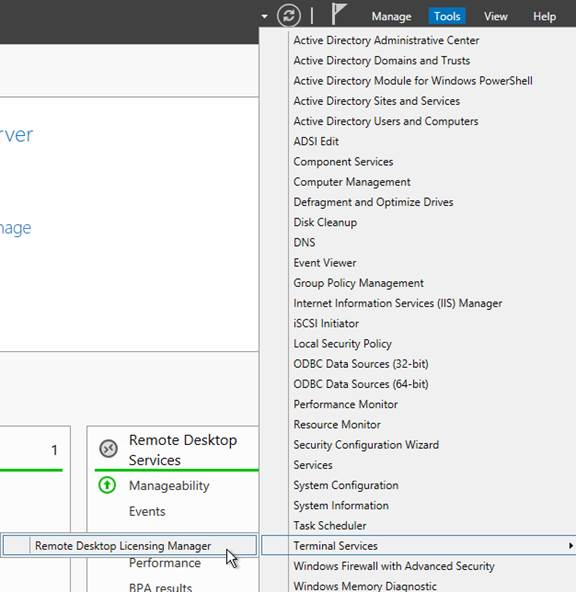
- The tool should find the local server. If it does not, right-click All servers, click Connect and type in the name of the local server. Once the local server can be seen in the list, right-click the server and click Activate Server.
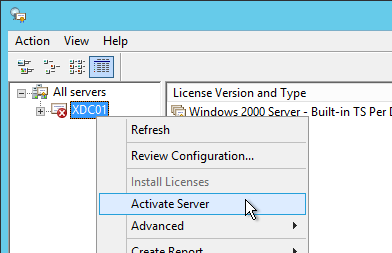
- In the Welcome to the Activate Server Wizard page, click Next.
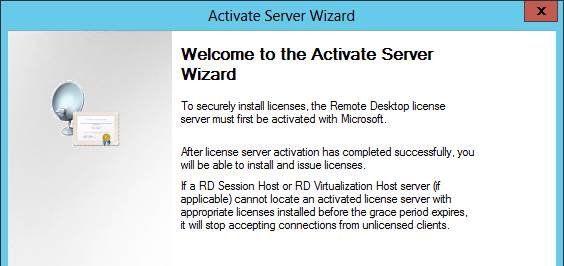
- In the Connection Method page, click Next.
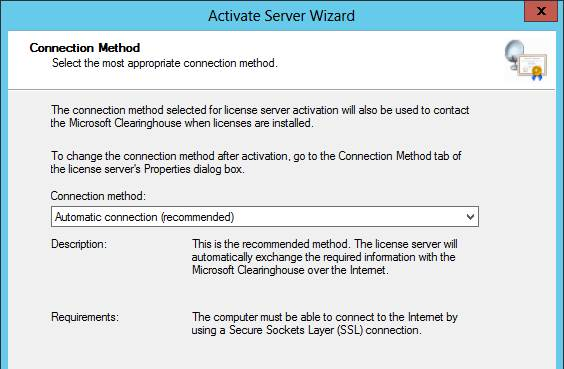
- In the Company Information page, enter the required information and click Next.
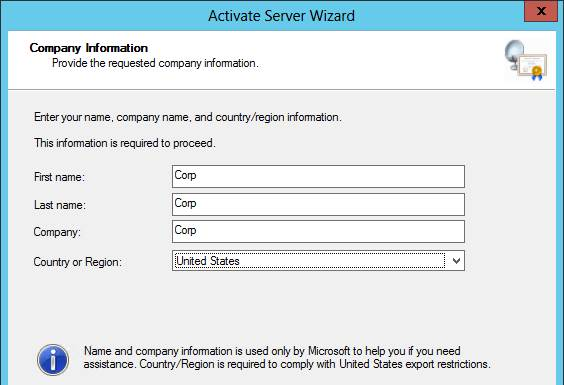
- All of the fields on the Company Information page are optional so you do not have to enter anything. Click Next.
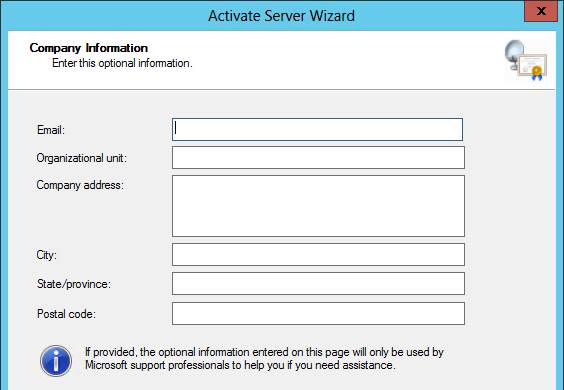
- In the Completing the Activate Server Wizard page, uncheck the box next to Start Install Licenses Wizard now and click Finish. Since the session hosts will be configured to pull Per User licenses, there is no need to install licenses on the RD Licensing Server.
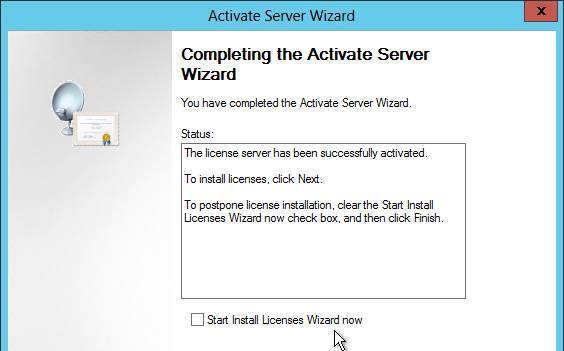
- In RD Licensing Manager, right-click the server and click Review Configuration.
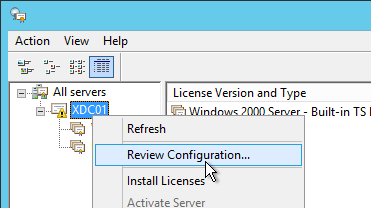
- Ensure you have green check marks. If the person installing Remote Desktop Licensing does not have permissions to add the server to the Terminal Server License Servers group in Active Directory, ask a domain admin to do it manually. If you have the proper permissions, click Add to Group.
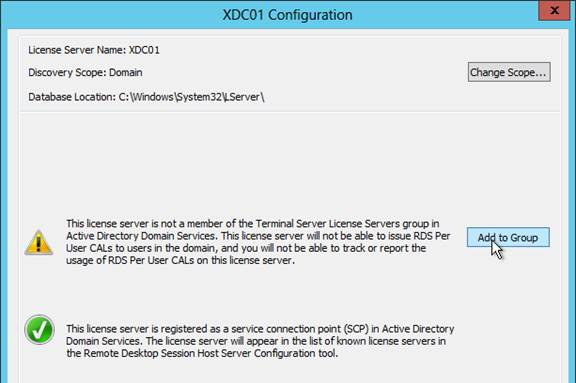
- Click Continue when prompted that you must have Domain Admins privileges.
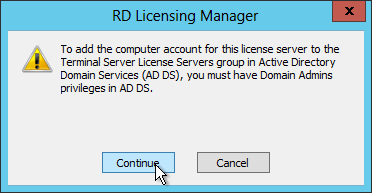
- Click OK when prompted that the computer account has been added.
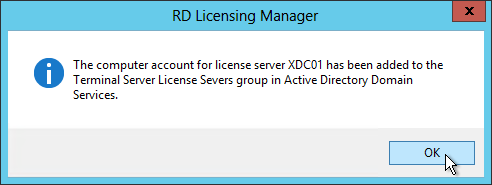
- Click OK to close the window.
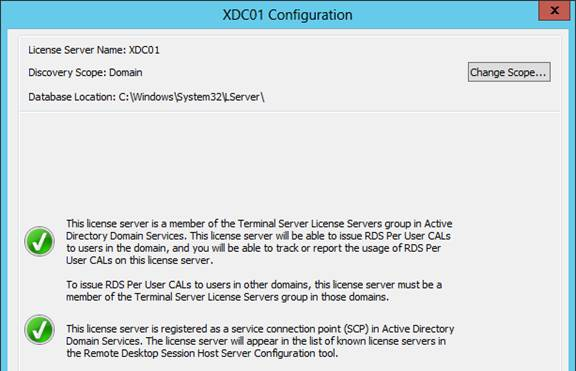
Health Check
Andrew Morgan – New Free Tool: Citrix Director Notification Service: The Citrix Director Notification service sits on an edge server as a service (or local to the delivery controller) and periodically checks the health of:
- Citrix Licensing.
- Database Connections.
- Broker Service.
- Core Services.
- Hypervisor Connections.
And if any of these items fall out of bounds, an SMTP alert is sent to the mailbox of your choice for action. The tool will also send “All Clear” emails when these items are resolved, ensuring you are aware when the service has resumed a healthy state.
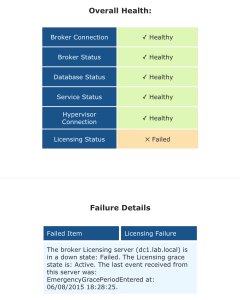
Hi Carl,
Is it possible to use a non Computer Object in AD to access the Citrix databases in XenApp 7.8?
Thanks,
Sam
I don’t think so.
Dear Carl, have a problem getting the single sign on to work from another machine.
Single singn-on to Director does only work if i open up the browser right on the controller, not if i come from another machine! The Director is installed on the controller.
I added the spn for the (controller/director) (fqdn), as you stated in the article.
I dont have any load balancing for the director in place!
I am not sure, do i have to go through part 8 of the Chapter “Single Sign On”
The spn can only be referenced once… so either for the user object or for the machine-fqdn.
so i guess all i have todo is use the controller fqdn as spn if no load balancing is in place right?
of course i did the other stuff like enabeling Windows authentication in IIS etc.
i use the http://controller.corp.local/director to access the director from another machine, but i have to sign in manually.
can you please help me out.
thanks David
It doesn’t work for me either. Other users reported the same problem. Citrix is not admitting to the problem.
hi Carl, I’ve upgraded citrix director to version 7.7, however there’s not ‘Alert’ tab, have any idea why? Btw, the controller is still with version 7.6, will there be any problem as I’ve read somewhere before it requires to have controller updated as well due to compatibility, is this the case?
Controllers need to be on 7.7 or 7.8 before Alerts become available.
Hey Carl, Do you know if StoreFront high availability is working with XenDesktop 7.7 When we were on 7.6 we had 2 sites, and used Storefront to Failover between the to sites when one was down. After upgrading to 7.7 I have created a primary zone and a secondary zone. Storefront now displays desktops from both sites e.g. Desktop (1) and Desktop (2) and ignores the code in the web.config file? Any ideas?
Thanks
Brenton.
StoreFront doesn’t understand zones yet. It works at the farm level.
Didn’t think so, might have to stick with to separate sites for now. Thank Carl
Hi Carl, after upgrade to 7.7 we have 2 issues:
– Using MCS to update the machines with a new master image is randomly leading to a broken trust relationship of the generated VM computer accounts and the AD. Sometimes it works, sometimes not (apparently depending on the state the VMs are in, but not reproducible)
Thought about applying the VDA hotfixes 7.6 301/302, as the VDA seems to be 7.6.300, but they seem to only be available for desktop and not for server OS, but we have the same issue with desktop and server OSes, so this can not be the solution.
– Studio can’t connect to the App-V server any more (simply doesn’t find it any more).Tried all thinkable notations, but no avail. Could imagine that it might only be an issue if non-standard ports are used (>32000 in our case) and that the App-V server is sitting on the same VM as the Citrix controller, but this is only an assumption.
Before the upgrade both issues have not existed. Everything else seems to be ok however.
Any other people experiencing the same issues or have any idea how to solve them?
Thank you
Udo
Updated to 7.7 last week same problem MCS does’nt work.
http://support.citrix.com/article/CTX200941 says its a permission error but the service account got the right permissions.
Rolled back to 7.6 and everything works again.
Update
This is a know bug ask for fix LC4511(will be included in 7.8)
Hi Carl, our environment is XD7.6 with Director version 7.6.300. I tried to upgrade just the Director component to 7.7 to make use of alerts/notifications feature. Upgrade went fine, however I am not seeing alerts tab at the top when I login. Still see 3 tabs (Dashboard, Trends & Filters) as in Director 7.6.
I suspect it requires Controller 7.7. Also, are you Platinum?
Yes
Hi Carl, In my environment (Server: XA7.6/Win2k8R2 Client: Win7x86) flash redirection works fine in IE app but not in desktop viewer. can u tell me how to resolve this issue.
Same VDA, same client? I’m not aware of any restrictions for desktop viewer. In the toolbar, is Flash Redirection enabled? Also see http://support.citrix.com/article/CTX136588
My Environment is Server: XA7.6/Win2k8R2, Client: Win7x86, Receiver is 3.4.500 in my Win7 client….when i play YouTube video in IE9 app flash redirection happen but when i opened YouTube inside desktop viewer server side flash player is used. i dont know how to resolve this.
There are much newer Receivers. Same with Receiver 4.4?
What hotfixes do you have installed on the VDA? VDA 7.6.300 (or 7.7) is the most recent.
Yes with receiver 4.4 also i am facing the same issue ..VDA 7.6.300 ..
Try creating a discussion at discussions.citrix.com. There are more readers there.
Ok Carl 🙂 ..thks for your reply 🙂
The upgrade path is easy however, There is a issues with VMware 5.5 update 2 and xenapp 7.7 with Director not talking to the hypervisor. I wouldn’t upgrade yet. Waiting for them to give me a fix. These guys test everything with xenserver. Its a totally different beast then VMware.
Upgrade path ? similar as the one from XA7.5 to XA7.6 ??
Yep. Half Delivery Controllers. Upgrade database. Other half delivery controllers. See “Upgrade Sequence” at http://docs.citrix.com/en-us/xenapp-and-xendesktop/7-7/upgrade-migrate/upgrade.html
Xenapp 7.7 is out?
Yep.